
Shared posts
Slow Cooker Carnitas
Okay, this might be the best thing I’ve ever made in my slow cooker. No joke. The combination of the subtle spices, orange essence, and richness of the slowly cooked pork is absolutely to die for. I hereby retire my chili rubbed pork in favor of these Slow Cooker Carnitas. I want to make sure I have some of this in my freezer at all times for tacos, burritos, and NACHOS. Oh yes, the nachos I could make with this pork…
If combining cinnamon and orange with pork sounds a little far fetched to you, don’t be scared! The flavors are subtle and add layers of flavor that you never imagined meat could have. It’s not sweet, it’s just amazing. Promise me you’ll try it.
While I used my slow cooker to cook the meat down until it was tender and juicy, I finished it off in a skillet to get some crispy edges. You want to wait until just before serving to crisp the meat up, so if you don’t plan on serving the entire 3 pounds of meat at once, store the rest in the cooking juices. I divided my slow cooked meat in half and transferred half of it to the freezer after chilling over night. I crisped the other half in a skillet and made deliciously rich little tacos with pickled red onions.
And YES, you can absolutely do this super fast using an Instant Pot. ;) Just layer everything in your IP as I did with my slow cooker, secure the lid, and press go. The Instant Pot manual suggests 45-50 minutes of high pressure for a pork butt roast.
Goes great with: Pickled Red Onions, Spicy Pickled Carrots, Cumin Lime Roasted Sweet Potatoes, Warm Corn and Avocado Salad
Slow Cooker Carnitas

- 1 yellow onion $0.32
- 4 cloves garlic $0.32
- 2 small cinnamon sticks $0.95
- ½ Tbsp oregano $0.08
- ½ Tbsp cumin $0.08
- ½ tsp salt $0.02
- Freshly cracked pepper $0.05
- ½ tsp chipotle pepper powder $0.05
- 3 lb. pork butt roast $5.26
- 2 small (or one large) orange $0.67
- Dice the onion and peel the garlic cloves. Place the onion, garlic, and cinnamon sticks in the bottom of the slow cooker.
- In a small bowl, combine the oregano, cumin, salt, pepper, and chipotle powder. Cut the pork roast into 2-inch cubes. Place the cubed meat in a bowl and sprinkle the spice mix over top. Toss the meat in the spices until evenly coated. Place the seasoned meat in the slow cooker on top of the onion, garlic, and cinnamon.
- Use a vegetable peeler to remove the thin layer of orange zest from one of the oranges. Squeeze about ½ cup juice from the oranges. Pour the orange juice over the meat in the slow cooker, than sprinkle the pieces of orange zest over top.
- Place a lid on the slow cooker, turn it on to high, and cook for 5 hours, or until the meat is tender and falls apart.
- Use tongs to stir and shred the meat, and remove the cinnamon sticks. Either divide the meat and liquid into smaller containers to refrigerate for later, or transfer the meat and some of the liquid to a skillet (preferably non-stick or cast iron). Cook the meat over medium flame until browned and crispy on the edges. Avoid stirring the meat too much as it will break down into tiny pieces. Use the crispy meat as a filling for tacos, burritos, nachos, or burrito bowls.


Step by Step Photos
 Dice an onion and peel four cloves of garlic. Place the diced onion, garlic cloves, and two small cinnamon sticks in the bottom of the slow cooker.
Dice an onion and peel four cloves of garlic. Place the diced onion, garlic cloves, and two small cinnamon sticks in the bottom of the slow cooker.
 These are the cinnamon sticks I use. These little packets of four small sticks are found in the Hispanic food section of my local grocery store and only cost $1.89. So, in if cinnamon sticks are expensive in the spice aisle, check the international foods aisle as well.
These are the cinnamon sticks I use. These little packets of four small sticks are found in the Hispanic food section of my local grocery store and only cost $1.89. So, in if cinnamon sticks are expensive in the spice aisle, check the international foods aisle as well.
 In a small bowl stir together 1/2 Tbsp oregano, 1/2 Tbsp cumin 1/2 tsp salt, some freshly cracked pepper, and 1/2 tsp chipotle pepper powder.
In a small bowl stir together 1/2 Tbsp oregano, 1/2 Tbsp cumin 1/2 tsp salt, some freshly cracked pepper, and 1/2 tsp chipotle pepper powder.
 You’ll also need one pork butt roast, about 3 lbs. If you use a bone-in roast, just get one slightly larger than 3 lbs. and don’t forget to pull the bones out after cooking.
You’ll also need one pork butt roast, about 3 lbs. If you use a bone-in roast, just get one slightly larger than 3 lbs. and don’t forget to pull the bones out after cooking.
 Cut the pork into 2-inch cubes, place them in a bowl, and sprinkle the spice mix over top. Toss the meat cubes in the spices until they’re evenly coated, then place them in the slow cooker on top of the onion, garlic, and cinnamon.
Cut the pork into 2-inch cubes, place them in a bowl, and sprinkle the spice mix over top. Toss the meat cubes in the spices until they’re evenly coated, then place them in the slow cooker on top of the onion, garlic, and cinnamon.
 Use a vegetable peeler to remove the zest from one of the oranges. You want to get all the nice orange parts with the fragrant oils, but not the white pith, which can be bitter. Also juice the oranges. You need about 1/2 cup juice.
Use a vegetable peeler to remove the zest from one of the oranges. You want to get all the nice orange parts with the fragrant oils, but not the white pith, which can be bitter. Also juice the oranges. You need about 1/2 cup juice.
 Pour the orange juice over the meat…
Pour the orange juice over the meat…
 And add those orange peels over top.
And add those orange peels over top.
 Place the lid on the slow cooker, turn it on to high, and cook for 5 hours. See how much liquid comes out of the meat? That’s good stuff right there.
Place the lid on the slow cooker, turn it on to high, and cook for 5 hours. See how much liquid comes out of the meat? That’s good stuff right there.
 Use a pair of tongs to stir and shred the meat. Fish out the cinnamon sticks (and bones, if you used a bone-in roast) at this time. You can serve the meat just as it is, or you can crisp it up in a skillet.
Use a pair of tongs to stir and shred the meat. Fish out the cinnamon sticks (and bones, if you used a bone-in roast) at this time. You can serve the meat just as it is, or you can crisp it up in a skillet.
 OR you can refrigerate it or freeze it for later. If refrigerating/freezing, I highly recommend dividing the meat up into smaller portions before refrigerating (store it with the cooking juices). This helps it cool faster and prevents food safety issues. If you want to freeze some of it, let it chill in the refrigerator over night before transferring to the freezer.
OR you can refrigerate it or freeze it for later. If refrigerating/freezing, I highly recommend dividing the meat up into smaller portions before refrigerating (store it with the cooking juices). This helps it cool faster and prevents food safety issues. If you want to freeze some of it, let it chill in the refrigerator over night before transferring to the freezer.
 To make the carnitas crispy, just cook it in a skillet with some of the juices (because you need the fat from the slow cooker to basically fry the meat) until it’s crispy. I recommend doing this in some sort of non-stick skillet though, like cast iron or teflon, because the liquified collagen likes to stick to and coat stainless steel.
To make the carnitas crispy, just cook it in a skillet with some of the juices (because you need the fat from the slow cooker to basically fry the meat) until it’s crispy. I recommend doing this in some sort of non-stick skillet though, like cast iron or teflon, because the liquified collagen likes to stick to and coat stainless steel.
 And that’s basically it! It’s just that easy to make tender, juicy, and FLAVORFUL slow cooker carnitas.
And that’s basically it! It’s just that easy to make tender, juicy, and FLAVORFUL slow cooker carnitas.
 Now excuse me while I go make the most epic nachos EVER. ;)
Now excuse me while I go make the most epic nachos EVER. ;)
The post Slow Cooker Carnitas appeared first on Budget Bytes.
Fridaaaay! Links
A.NFor the Amazon Dash Button
Accomplishment of a lifetime: I Was a Black, Female Thru Hiker on the Appalachian Trail.
Speaking of explorers, did you see this piece in California Sunday about the private citizens who are building their own (feasible) rockets to Mars? Mars Madness: “You have this dream to do this really cool thing, but you always think in the beginning: It’s not for you. It’s not gonna happen …. Then one day you start to realize: It could be you.”
Man sells his tattooed skin to art collector who will have him flayed when he dies. Sure.
Useful: Neven’s simple checklist of things to remember when you launch a new project.
Tabletop Moonshine Still — Let’s get one and have moonshine parties when the moon is shiny.
Good price on this dress for your gallery show.
#Museum101 is the hashtag you add to creepy/amazing stuff from museum collections. I got you guys something.
This story reminds me of how few disciplines have access to data scientists, and software designers and engineers. Serial Killers Should Fear This Algorithm
“Using Freedom of Information Act (FOIA) requests, MAP has tried to chase down data from the many municipalities and counties that weren’t supplying their murder data to the FBI, out of bureaucratic laziness, a lack of manpower, or perhaps just rank incompetence. MAP has already assembled case details on 638,454 homicides from 1980 through 2014, including 23,219 cases that hadn’t been reported to the FBI. This is the most complete list of case-level details of U.S. murders available anywhere, and the group’s website has open-sourced all of it.”
How to make an amazon dash button that gives the ACLU $5 Every Time You See Something Terrible
Cute, ultra-simple place cards from Oh Happy Day for our Shiny Moon parties.
The post Fridaaaay! Links appeared first on Mighty Girl.
Double-Chocolate Meringue Fudgies
Faces in Things
Ever see a face in everyday objects? This Twitter user collects and shares them. An instant favorite.
(via Chris)
NOPE Button
This Nope Button Chrome extension is just what the office world needs: A coworker drops by and wants to ‘pick your brain’? Press a button in your Chrome browser to send a call to your phone. Apologize sincerely as you pick it up. Then watch your co-worker walks away. Funny.
The Wisdom of Nokia's Dumbphone
They weighed heavy in pockets and jackets and bags, for they were thick and bulky, not lithe and narrow. Harried professionals never clutched one ostentatiously to say silently, “I’ve got better things to do than listen to this pitch or order this coffee.” Fashionable youth never dangled one nonchalantly from fingers as a flirty pique. Nothing was less sexy or less useful than a cell phone.
How is it possible, then, that Nokia has announced an updated edition of one of its most popular phones of the early aughts, the 3310? In short, because nothing has become less sexy or less useful than a smartphone.
* * *
First released in 2000, the Nokia 3310 emerged during the Cambrian explosion of mobile devices. Fashionless black bricks crossed the paths of colorful, candy-bar handsets. Slim, black Ericsson flip-phones shared airport security bins alongside silvered Motorola clamshells. WAP-enabled “feature phones” offered rudimentary, useless access to the internet, while the fat fingers of government officials and corporate executives mashed the keys of BlackBerry 957s and Treo 180s. Teens thumb-typed too—but texts instead of emails, on Danger Hiptops. The Nokia N-Gage even tried, and failed, to merge the mobile handset with the portable game system. Over the first half-decade of mass-market mobile devices, everything was attempted and nothing was holy.
In retrospect, the story of all these devices’ downfall is an obvious one. BlackBerry and Palm had failed to guess that smartphones would appeal to a general audience, not just to business users. They’d also mistaken the physical keyboard for a requirement. And all the rest of them, flip or clamshell or candy-bar, had assumed that phone calls and text messages would define portable handheld computing.
Instead, in 2007, Apple made a general-purpose touch-interface computer in the form of a thin glass rectangle, which others have copied and adapted ever since. 10 years later all anyone does, pretty much, is stroke and fondle one of these things, all day long. And for the privilege, consumers pay big bucks, continuously, to keep up with planned obsolescence reinvented as seasonal fashion.
The shame of a habit can only emerge once it has reached ubiquity. Even though the risk of compulsive obsession with smartphones was clear halfway into their ten-year life, the trauma of that obsession is only starting to dawn on people.
There are reasons. Years of odious abuse on services like Twitter and Reddit have finally mestastasized into resigned admission. The logic of amplifying information based on popularity, as Google and Facebook do, has finally revealed its obvious downsides. The demand of constant, unceasing attention from apps like Snapchat and games like Candy Crush Saga has begun to feel like the unpaid labor it always was.
For years, internet-driven, mobile computing technology was heralded as either angel or devil. Only recently has it become possible to admit that it might be both. Cigarettes, after all, produce pleasure even as they slowly kill.
Given the rising angst of a society run by technology, Nokia might have picked the perfect time to introduce an antidote to the smartphone. But even under today’s conditions, it is tempting to see the new Nokia 3310 merely as another example of retro nostalgia. Ha-ha, what if you could get a dumbphone instead? It would pair perfectly with a milk crate full of vinyl albums. But it’s also possible that the 3310 marks the start of a new period of technological mobility. One that offers a sense of how even the most entrenched technological habits might yet turn out differently.
* * *
Phones like the Nokia 3310 never went fully extinct, despite the geological devastation of the iPhonecene. Thanks to their low cost, feature phones have remained popular in the developing world, where they have always been more common than traditional computers. Even in sub-Saharan Africa, smartphones only overtook feature phones sales in the last two years. HMD Global, the Finnish company that licensed Nokia technology and branding back from Microsoft sees more opportunity in these markets. Late last year, the company unveiled two new, $25 feature phone models, marketed to the billions of feature phone users in Europe, the Asia Pacific, India, the Middle East, and Africa.
Since the iPhone and Android rose to prominence, high-quality, reliable alternatives to smartphones have all but disappeared in the developed world. And where they remained, they have become so uncool as to make their adoption grounds for public shame.
But there are reasons to prefer a phone as a portable communications tool instead of a compulsive, general-purpose computer. Some of those reasons recall the original uses of the cell phone. When it first became generally popular in the late 1990s, mobile handsets often were bought as insurance against surprises or emergencies. People tossed them into automobile glove boxes, or carried them in pockets or purses only when the perception of risk or the need for coordination seemed required. Those concerns persist, especially now that people have become accustomed to being able to reach one another immediately and constantly. An inexpensive, reliable handset with a long-lasting battery might turn the Nokia 3310 a second phone, or a backup phone.
Another possible use is domestic. Once mobile phones became ubiquitous, many households gave up on home phone lines. By 2012, more than half of American homes didn’t have a landline. But the decline of the home phone also had unexpected consequences. Smartphones are personal devices, while the home phone line is a shared resource. As mom, dad, and all of the kids began getting their own, private communication tools, the phone as a point of entry to the household disappeared. But there’s reason to imagine a future in which the telephonic hearth renews. A cheap, appealing device like the Nokia 3310 could be left on the kitchen counter, ready to cry its loud, familiar ring as a means of reaching the home in general, rather than one of its occupants. Anyone who has missed a service call because the iPhone was on silent on the nightstand, or awkwardly passed around a personal device with grandma and grandpa on the other end, might willingly add another line to avoid such discomforts.
Then there’s the matter of smartphones’ overall sameness. Last year, my colleague Robinson Meyer profiled the Caterpillar S60, a smartphone designed by the heavy equipment company, built for construction work. Rugged and reinforced, it can be dropped from heights, immersed, and exposed to the elements. Rob rightly called the future that the Caterpillar S60 represents one in which “smartphones become unboring.” Boredom ends not thanks to the absolution of some newfangled feature that everyone needs, but from the specific features useful in particular circumstances.
The simultaneous fragility and expense of smartphones also helps explain why the Nokia 3310 might appeal even to consumers who can afford better. Speaking to The Guardian, the industry analyst Ben Wood cited the “festival phone” and the “backup phone” as possible contexts for the handset. When working in the yard, camping, or white-water rafting, the risk of damaging or destroying a $750 smartphone makes carrying one seem foolish. But what other choice is there? Likewise, when attending a concert or sporting event, thin smartphones might risk getting lost or stolen. In these instances, a $50 Nokia 3310 offers clear benefit.
Security and privacy offer more reasons to consider a dumbphone. Smartphones are sophisticated tracking devices. GPS and motion sensors, along with the always-on internet servicing dozens of apps doing unspecified processing in the background make these devices encyclopedias of their users’ actions and behavior. While the cellular network can always be used to determine a handset’s location, the granularity and accuracy of its physical tracking is limited compared to a GPS device. And given recent examples of border agents demanding access to travelers’ smartphones, feature phones might become standard equipment for frequent travelers.
Upon arrival, the feature phone might even prove a more useful tool than the smartphone to the jetsetter. How much energy do business travelers expend managing the power and network needs of their smart devices at meetings or conferences? True, the Nokia 3310 can’t direct owners around an unfamiliar city on a map, or allow them to live-tweet an event. But perhaps the need to keep a smartphone powered and connected to the network—not to mention the compulsion to use all those apps—would be reduced given a second device meant solely for communication.
The Nokia 3310 might also offer an alternative to smartphones for younger kids. It’s much easier for a preteen to signal a pickup by phone or text than to try to guess when and where to arrive. Some parents, myself included, try to pawn off cheap, basic phones to children as they become old enough to pursue schedules outside the home. But these tools are devoid of style. They are embarrassments, without appeal, and as such they become more likely to go unused or left at home. Should Nokia rekindle the cultural allure of the feature phone, perhaps its potential as a communications tool absent the urges of the smartphone will inspire parents to stop handing over these glass-and-metal temptations to their progeny without a second thought.
* * *
It might be premature to announce the end of humanity’s love affair with the smartphone. But the relationship’s cracks are surely showing. Some have immediate consequence. Apps have contributed to a huge spike in traffic accidents and deaths, as more and more people attempt to operate finicky handheld devices while driving. The partial-reinforcement techniques baked into today’s apps and games has become more apparent to users, who seem increasingly resigned to services they also feel no option to quit. And the uniformity in design of devices has arrested their future potential. Every year another glass rectangle, affording no more or less than it promises, which is more of the same.
The smartphone’s conquest is definitive and complete. A decade after its form solidified, the contemporary citizen of the developed world has almost no choice but to own and operate one. And yet, the joy and the utility of doing so has declined, if not ceased entirely.
People called them called cell phones, or mobile phones, depending on the home continent of their carriers. “Cell phone” highlighted the empty space between communication nodes—the cells—common to North America. In Europe, where the land is flat, the nations small, and the coverage ubiquitous, versatility took center stage: the capacity to remain connected while in on the move thanks to a “mobile.” These name describe dreams as much as reality. Likewise, “smartphone” is wishful thinking as much as anything. A skeleton key, an aluminum genius, a singular device that deploys software, connectivity, portability, and design to end, finally and definitively, the ideal purpose of universal computation.
But the truly smart actor does not use one single tool, but the right tool for the job. That the right tool might always be one forged in software and activated via touch and gesture always should have been as preposterous as it is now only starting to seem. The Nokia 3310 isn’t the answer to the future of mobile telecommunications, or computing, or digital fashion, or any of the other domains in which the iPhone has pulled the wool over collective eyes. Instead it can be just what it is: one specimen in an ecosystem of technical diversity. The future promise of Nokia’s device isn’t this particular device, but the alternate, unthought future it represents.
Sign with Robert




Robert teaches you sign language trhough animated GIFs. Love this!
What’s your favorite romantic spot in DC? Mine may be the...

What’s your favorite romantic spot in DC? Mine may be the Spanish Steps in Kalorama. Built in 1911, this hidden park (the only one in the city that occupies a street) has the charm of the an old European alley, and provides a scenic background for first kisses, proposals and weddings (not necessarily in that order).
Vogue x Tattly
Tattly recently launched the biggest collaboration to date: A vintage Vogue collection. The illustrations, all from the early 1900’s, celebrate Vogue’s 125th anniversary! It is an incredibly honor to be partnering with a prestigious brand such as Vogue. My heart!
Honestly, they should have called it Labiastick.
The secret weapon for helping people with Aspergers succeed as adults

I coached this guy Tanner who invented a thing to make milk flow smoothly in tubes and now he’s a millionaire tech CEO. During his fifteen-year marriage he’s scheduled sex with his wife, on a calendar, a year in advance. He was surprised to hear other couples do not do this.
And yes, he gave me permission to tell you this. He doesn’t care. He has Aspergers. Which is the point of this post. Don’t think of Aspergers as a social skills thing because smart adults can avoid social skills. I mean, think about it. Every time I make a public appearance, I find a place to hide.
So Aspergers is more like a social not-caring disorder. Because Tanner knows everyone has sex, so he has no idea why people care so much about sharing details.
Jacob is a music producer. I went to LA with my son to make a recording.
Jacob had car trouble on the freeway, so he drove off the side of a merge ramp that had a 70-foot drop to the freeway below. He said it was his safest option. I didn’t believe it until he took me to see the fence he landed on.
After a weekend with Jacob, we were hanging out in a big, oak-paneled auditorium, taking a break in between recording sessions, and my son said, “Mom, you and Jacob are crazy in the same way.”
“Like what?”
“Like, you don’t know your left and right and neither does he.”
“Wait. Jacob, you don’t know your left and right?”
“No. I can’t tell time either.”
“Me either! Because time is left and right, right?”
“Mom! I can’t take it. Call Melissa!”
Call Melissa is what my kids say when they think I’m messing things up. Like:
I can’t remember what airline we’re on.
Call Melissa.
We don’t have money because I lost both my bankcards.
Call Melissa.
Last week my younger son was locked out of the house and instead of calling me, he called Melissa. And even though she is 6000 miles away in San Francisco, she could help him: “Go to the knitting shop. There’s a key under the rock. I told Mom to hide it there just in case.”
It turns out that Jacob has his own version of Melissa. A roommate who manages his life for him. His roommate has been his roommate for 15 years and now thinks nothing of talking for Jacob.
They were talking to a potential corporate client for recording and the client said, “Can you just let Jacob talk for himself?”
Jacob sees all questions as an invitation for soliloquy, on any topic.
Five minutes later his roommate said, “You can see now that I wasn’t talking for Jacob for his benefit, I was talking for Jacob for your benefit.”
The most common reaction people have to someone who has a very high IQ and Aspergers is that that don’t have Aspergers. The most common thing I hear from Tanner’s wife and Jacob’s friend, “No one would ever believe what I deal with.” (Melissa’s version of this is, “Write that down. It has to go on the blog.”)
People have no idea what to do when confronted with someone who seems perfectly normal, and extraordinarily successful, but actually has Aspergers.
My husband was so frustrated when a reality TV crew filmed our family at the farm for three days. He thought people would finally see how crazy it is to live with an adult with Aspergers, but in fact, the show got canceled because TLC said “Penelope and her family are too normal.”
My husband said it’s because we never left our house and I can control my environment at home. He says the producers should have watched me shop in the grocery store because I run people over with my cart all the time. (To be clear, I have never noticed this but he says that’s the whole problem. He says people give me dirty looks like they want to kill me and I don’t bat an eye.)
People ask me all the time how to help transition kids into adulthood. Based on the very successful people I know who have Aspergers, there is always someone on the sidelines functioning as a safety net.
And this doesn’t appear to be something you can pay someone to do. In fact it appears that it cost people money to help someone with Aspergers. Tanner’s wife comes from a wealthy family, which is good because Tanner doesn’t share his money. (He says he loves his wife very much, and he will buy her whatever she wants. She just needs to ask.) So when he wears black shorts to a black-tie event because he didn’t like fabric on his pants, she uses her own money to have a new tux delivered in less than an hour.
The roommate pays extra rent when Jacob gets fired. Which is frequently. (The last time was when his boss said, “If I were you I’d record that kid first because his dad is a donor.” Jacob said, “Oh.” Jacob did not record the kid. He was surprised when he got fired.)
People with Aspergers routinely perform at the top of their class throughout school. Eighty-five percent of people with Aspergers are unemployed. Thirty-five percent of people with Aspergers think about suicide. Here are links. They are not exact. I do not care that I’m not giving you exact numbers. I think numbers are a feeling.
As a society we have become adept at identifying Aspergers. So adept that we still use the term even though the DSM has declared that term is not a term anymore. But we have a terrible track record for dealing with it.
Part of the problem is people cannot understand how someone so smart could fail so profoundly. Another problem is humans naturally project: you figure that if addition is easy for you and you could do 2+2 when you were in kindergarten then I must be a lying psycho idiot when I tell you I can’t do basic third-grade arithmetic.
Another part of the problem is there is little understanding of the special type of support that someone with Aspergers needs as an adult. After seeing people like Tanner and Jacob I see my own situation better. I think success hinges on finding someone who loves you. But that’s not enough. That person has to be good at doing the things the person with Aspergers is not good at doing.
The person also needs to be normal. Which is why Tanner’s name is not really Tanner. Because his wife might have an extraordinary heart but she has a standard sense of privacy. Still, I ask her if I can write about the time he called 911 for her and then finished watching a movie because the rental period would run out before they got home from the emergency room.
“Go ahead,” she said, “if that’s what it takes for people to start questioning what high IQ really means.”
The Big Idea: Matt Ruff

Books are often turned into television series — but what about stories going to the other direction? As Matt Ruff shows you in this Big Idea for Lovecraft Country, stories intended for one medium sometimes find their full flower in another entirely.
MATT RUFF:
Lovecraft Country started out as a TV series pitch. The big idea was to create a show like The X-Files, in which a recurring cast of characters had weekly paranormal adventures—only instead of being white FBI agents, my protagonists are a black family who own a travel agency in 1950s Chicago. The agency publishes a quarterly magazine, The Safe Negro Travel Guide, that lists and reviews hotels and restaurants open to black customers. (Such travel guides actually existed during the Jim Crow era, and contrary to what you might expect, they were most useful to travelers in the northern and western U.S., where discrimination was just as common as in the south but explicit “Whites Only” signs were rarer.)
My lead character, Atticus Turner, is a 22-year-old Army veteran who works as a field researcher for the Guide. Atticus is also a nerd whose familiarity with genre fiction comes in handy when things start to get weird, as they do: It turns out Atticus is the last living descendant of Titus Braithwhite, an 18th-century wizard and slave trader who founded a cabal called the Order of the Ancient Dawn. Now the modern incarnation of the Order has plans for Atticus.
In addition to occult forces, Atticus and his family have to deal with the more mundane terrors of American racism, such as sundown towns. Lovecraft Country’s title is a nod to this duality of horrors—H.P. Lovecraft being known for both his tales of cosmic dread and his embrace of white supremacy.
While transforming my original idea into a novel, I kept the structure of a season of television. The long opening chapter, like a two-hour pilot, introduces the main characters and sends them on a dangerous cross-country journey. Each subsequent chapter offers a self-contained weird tale—a “monster of the week” episode—starring a different member of Atticus’s extended family. In “Dreams of the Which House,” Atticus’s friend Letitia buys a haunted house in a white neighborhood and has to play the dead off against the living to keep what’s hers. In “Abdullah’s Book,” Atticus’s uncle George enlists his Freemasons’ lodge to stop an ancient treatise on magic from falling into the wrong hands. In “Hippolyta Disturbs the Universe,” Atticus’s aunt discovers a portal to another world. In “Jekyll in Hyde Park,” Letitia’s sister Ruby goes home with the wrong guy and wakes up to find that she’s been turned into a white woman. In “The Narrow House,” a dead man forces Atticus’s father to revisit the 1921 Tulsa race riot. In “Horace and the Devil Doll,” corrupt Chicago police detectives use sorcery to terrorize Atticus’s 12-year-old cousin. All of these episodes fit together to form a larger arc story about Atticus’s struggle against the Braithwhite clan and the Order of the Ancient Dawn.
For me, Lovecraft Country demonstrates the real power of diversity in art. By focusing on people who were traditionally excluded from genre fiction, I’m able to do interesting new things with some very old tropes, while simultaneously exploring aspects of our shared history that aren’t as well-known as they should be. Combining fantasy with realism produces a richer story than would be possible with either alone. And despite being set sixty years in the past, this is easily one of the most topical books I’ve written—though that says less about my skills as an author than it does about the state of the country that I live in.
—-
Lovecraft Country: Amazon|Barnes & Noble|Indiebound|Powell’s
Read an excerpt (pdf link). Visit the author’s blog. Follow him on Twitter.
Black People Explain to Kids How to Deal with the Police
One of the ways I really woke up to how bad racism is in the U.S. was reading an article in Ebony magazine about how to talk to your kids about police. It was in amongst articles about skin products and travel, right there in the middle of all the regular lifestyle magazine stuff. Something about the juxtaposition really brought it home for me emotionally. I knew that talking to your kids about the police is a rote conversation in our black communities, similar to a “birds and bees” talk, but I didn’t understand it emotionally until that moment.
After that, I started going deep every time I heard about another black person hurt or killed by police. I followed all the news, educated myself whenever it happened. I was shocked, and eventually devastated, by how mundane it is. It has become necessary to scare the shit out of your very young American kids, scare them to tears, so they don’t accidentally reach for their license in the presence of an officer who then kills them because they believe the kid is reaching for a gun.
Anyway, if you’re not black and you feel confused, or like there’s something you’re missing, consider just tuning in a little more. Watch the video above, maybe subscribe to Ebony (it’s like $18), follow a dozen black people on Twitter. Don’t bug any strangers, don’t argue with anyone on social media, just listen to the conversation and feelings happening in a few of our black communities. Google stuff you don’t understand, and see what you can learn.
The post Black People Explain to Kids How to Deal with the Police appeared first on Mighty Girl.
It Came From The Search Terms: February Stars
A.N25 & 26
It’s time to answer the questions people typed into their search engine as if they really asked them.
1. “How to make him want to start a family.”
There’s no making anybody want anything. Do you want to start a family? Then tell “him” what you want and ask him what he wants. “I know I want to have children, and I’m feeling ready to get started doing that. What do you think? What kind of timeline makes sense for us?”
If he wants to have children, too, you’ll find out and you can get started. If he doesn’t want children at all, or if his answer is a perpetual “someday,” well, you’ll know that too and can make some decisions about how to move forward. If this is the right person to start a family with, ask him. Speak your heart’s desire.
2. “How to be uninhibited during orgasm without disturbing the neighbours?”
If you live really close to other people you’re all gonna hear stuff sometimes. Earplugs, white noise machines, headphones, carpets, and heavy curtains are your friends. Part of living communally is learning to tune some things out and deal with a little background noise. Your neighbors will survive hearing you Do It every now and then as you survive the odd loud party or bit of toddler parkour. Still, to be maximally considerate:
- Be generally aware of school nights/workweek nights and keep it quiet when you know it will likely keep someone awake or awaken them too early. (Try kissing when you feel a yell about to come out).
- Use music or white noise machines. I knew my former upstairs neighbors were having sex the second Wicked Game came on (every time…every single time) but I appreciated the muffling attempt and the plausible deniability, and no doubt they appreciated the sonic smokescreen that let them have maximum fun!
- Sound-proof your space. A rug on the floor. Heavy curtains over the windows and sometimes around the walls. Cover or block the nooks and crannies through which voices carry.
- Done some soundproofing? Have a good time.
3. “Girl at work hardly ever speaks.”
Okay?
4. “Not ready for a relationship right now after a bad break-up.”
It’s totally fine to need some time after a breakup to fall back in love with yourself and the world.
If someone is telling you this, believe them.
If someone is telling you this and sleeping with you/doing other relationshippy-sort-of-stuff with you thats full of mixed signals, also definitely believe them. If people really want to be in a relationship with you they are capable of making many, many adjustments in their lives to do so, and it’s okay to say, “I hear you, call me if that changes!” and walk away from their sexy-and-confused selves.
5. “My ex says she doesn’t want a relationship.”
Then you don’t have a relationship. It really is that simple.
6. “What does it mean when someone says they don’t have time for a relationship.”
It means they are choosing not to pursue a relationship (with you), very likely due to having too much other stuff going on. Always reframe statements like this as a choice. It will set you free.
7. “Should I tell my mom my dad hit me?”
Generally, yes, I think you should, but if what’s stopping you from telling her is an instinct that says “If I tell her I will be even less safe than I already am” then use your own judgment about that.
If your mom isn’t the right person to start with, please tell somebody. I don’t know how old you are, anonymous internet searcher, but a school counselor or other adult you trust can be a good place to start. Also, here’s the National Domestic Violence Hotline number in the USA if you need to talk to someone anonymously at first. If you’re not in the USA, get on a computer your folks don’t have access to or open an incognito browser window and search for “domestic violence hotline” and your location.
8. “When a guy asks if you’re mad at him.”
Are you mad at him?
Were you even paying enough attention to be mad at him?
If you aren’t mad, and you weren’t really even paying attention, try “No, should I be?” if he asks you about it again?
9. “How best to deal with someone you care about but they are mean to you?”
Tell them to knock off the mean behavior, and avoid them until/unless they do.
10. “How to dump a guy you kissed once.”
A kiss is not a contract, so, try some version of: “I’ve enjoyed getting to know you but I don’t want to be romantically involved with you. So sorry, I wish you all the best, goodbye.”
11. “What’s the meaning of ‘no thanks but nice to meet you’?”
One possible translation: “Thanks for hanging out/coming on this internet date today, I appreciate the effort that you took to wear a clean shirt and make small talk with a stranger, you seem nice enough, but we won’t be doing that again. Have a great life!”
12. “How to deal with your Catholic parents who are insisting that you have your child baptized Catholic and you don’t want to do that.”
“You got to choose this for your children, I get to choose for mine. Let’s find a new topic, please, or I’m going to have to hang up the phone/Grandbaby and I are gonna have to wrap up this visit for the day.”
Be alert to the possibility they might take your child to be baptized anyway behind your back since apparently that’s a thing people do.
13. “How can I tell my boyfriend he smells like urine when I go down on him sometimes.”
Awkward Sex Rule: If you’re close enough to someone that you sometimes put your mouth on their parts, you’re close enough to say “Babe, let’s pick this up after a shower” or to go “hands only” if you don’t want to interrupt the action right then and/or to let him know at another time”Hey can you take special care to clean up down there before we get it on? It takes me out of the moment if things are funky.”
14. “Write a letter to your friend with whom you had a quarrel, giving three reasons why you and him should resume your friendship.”
Three reasons?
Maybe try this:
“Friend, I’m really sorry for [specific thing that led to quarrel and us not being friends anymore, WITHOUT making excuses or trying to justify it or explain further, ONLY apologizing]. I really miss our friendship and I hope we can talk again soon when you’re ready.”
Send it out there, give the friend time and space, and see what happens. That’s all you can really do – all the reasons in the world won’t outweigh a sincere apology and sincere request to reconnect or convince someone who doesn’t want to be friends to come back.
15. “My boyfriend tells me to exercise and watch what I eat. It makes me feel horrible.”
Dump. Him.
16. “When bf doesnt want u to meet his friends.”
Dump. Him.
17. “How do you describe a relationship whereby you’re the only one forever reaching out for that person?”
One-sided? Unsatisfying? Soon-to-be-over?
18. “My boyfriend only cares about himself in bed.”
Dump. Him.
19. “Husband doesn’t like short dresses.”
Husband should only wear long dresses then, on his body i.e. the only body of which he is the boss.
20. “My old teacher doesn’t seem to remember me.”
Aw, that can be a really sucky feeling, but it happens. Your teacher has known a lot of students and it’s reasonable to think they might have trouble placing you especially if some time has passed. Gently remind said teacher that you enjoyed his or her class and take it from there.
21. “Korean boyfriend ghost dumped me.”
Getting dumped sucks, no matter how it happens. I’m so sorry. Remind yourself “He didn’t even care enough to tell me it was over” as a way to help yourself let go.
I would read a novel about a breakup with a Korean ghost-boyfriend.
22. “How to tell your boyfriend you don’t want to live together.”
“I prefer living alone.” “I don’t want us to live together.” “I’m not ready to live with you.” “Let’s not live together.” “I don’t see us living together.”
If he really wants to live with you, and you don’t want to live with him, there’s no magical way to deliver that news that won’t hurt his feelings or make him sad, but you gotta tell him so that you can both make good decisions about your relationship and living situation. People can have good relationships and live separately. Trust your instincts on this one and do not “try it out” if you aren’t feeling it.
23. “Dear Prudence sucks.”
She used to suck especially with regard to consent and sexual assault. Now she’s Mallory, and she’s pretty great.
24. “What do you do if your cousin passed away but you weren’t close.”
Consider sending a card to his parents and tell them you’re sorry for their loss. Greeting cards were invented for just this situation, you just have to sign your name at the bottom, and it will be a nice gesture of kindness to them.
25. What does the big relationship elephant in the room mean?
The “elephant in the room” is an idiom that refers to “the giant glaring problem that everyone is pretending not to see or talk about.” So this would be “the obvious problem in the relationship that we aren’t discussing for some reason.” Here’s hoping that it’s a cute baby elephant?
26. “How to stay informed politically without anxiety attack.”
I DON’T KNOW. I AM NOT DOING A GOOD JOB OF THIS. DID YOU SEE THE ELEPHANT VIDEO, THO?
27. Random shoutout to my friend Erin Lynn Jeffreys Hodges.
Hi! Hi! Hello!
This post brought to you by Patreon supporters. This also marks the opening of the 2017 Winter Pledge Drive where I gently shake the tip jar in the general direction of my wonderful audience. Thank you for reading.
A Writer’s Turmoil in The Rules Do Not Apply
Don’t be fooled by this book’s neon cover, or by what could be taken as the Trumpian tone of its title. Ariel Levy’s subject is sudden, all-encompassing loss—of a son, a spouse, a house, and, along with them, “my ideas about the kind of life I’d imagined I was due.” When her world was upended, she had not yet turned 40.
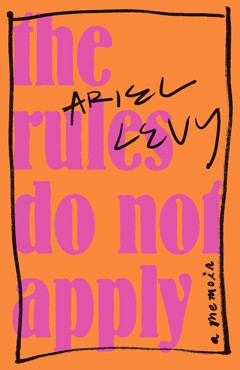
Levy, who began her career at New York magazine before joining The New Yorker as a staff writer in 2008, knew early on “the kind of woman I wanted to become: one who is free to do whatever she chooses.” A bold and bookish girl growing up in Westchester, New York, in a pre-9/11 world, she thrived throughout her 20s and into her 30s on “a compulsion to thrust myself toward adventure.” She had male and female lovers. She traveled to far-flung places. Her journalistic specialty was “stories about women who are too much.”
Levy counted herself among that undaunted company. She still qualifies, even after being buffeted by deep grief in marriage and pregnancy, and chastened to learn how much in life eludes control. Levy has the rare gift of seeing herself with fierce, unforgiving clarity. And she deploys prose to match, raw and agile. She plumbs the commotion deep within and takes the measure of her have-it-all generation.
Without giving away her story, I don’t think you can beat this as a trailer for the turmoil unleashed in her one-of-a-kind memoir: “And the truth is, the ten or twenty minutes I was somebody’s mother were black magic. There is nothing I would trade them for. There is no place I would rather have seen.”
Donald Trump's Blunder Down Under
Dishonor and distraction. That is what Donald Trump brought the United States Wednesday when news broke that he inexplicably lashed out at the prime minister of Australia in a phone call, tried to renege on an agreement between the two nations, and bragged as ever about himself. To add insult to insolence, he then took to Twitter to complain.
The Washington Post first reported on the self-indulgent outburst:
President Trump blasted Australian Prime Minister Malcolm Turnbull over a refugee agreement and boasted about the magnitude of his electoral college win, according to senior U.S. officials briefed on the Saturday exchange. Then, 25 minutes into what was expected to be an hour-long call, Trump abruptly ended it. At one point, Trump informed Turnbull that he had spoken with four other world leaders that day — including Russian President Vladimir Putin — and that “this was the worst call by far.”
Trump’s behavior suggests that he is capable of subjecting world leaders, including close allies, to a version of the vitriol he frequently employs against political adversaries and news organizations in speeches and on Twitter.
Australian media sources soon confirmed parts of the story.
By Thursday, a columnist at the Sydney Morning Herald had coined a new name for the president of the United States: “Donald Trump is the Mad King: volatile, vainglorious, and untrustworthy,” Mark Kenny wrote. “Trump is now gainsaying his own private commitments, via Twitter. This is an extraordinary situation and one that is almost impossible to manage. American prestige is on the line.” In fact, it took a hit.
President Obama’s critics argued that the United States was no longer respected under his tenure. Trump assured his voters that he alone would make America respected again. After barely a week his undisciplined antics have damaged America’s standing with multiple allies. “World leaders be warned,” the Australian newspaper declared. “Trump's conversations are not private and his word, unreliable.”
Who can now deny that?
Other allies were watching. Trump’s behavior made all the British papers. The story in the conservative Telegraph at one point characterized Trump as having a “tantrum.”
And the image Trump has projected to the world is bullying disloyalty.
After all, there is no country that has stood by the U.S. like Australia. The two nations’ soldiers fought alongside each other in World War I, World War II, Korea, Vietnam, the Persian Gulf, Afghanistan, and Iraq. They’ve helped America battle al-Qaeda and ISIS. They are a member of the Five Eyes, an intelligence alliance of English-speaking countries that shares mutually beneficial information. That all counts for something. Our shared language and similar cultures do, too. But the alliance is not to be taken for granted.
The prosperity of Australians is no longer mainly a function of their relationship with the United States. “The rise of China has created the unprecedented situation in which Australia's major trading partner sits outside the U.S. alliance framework, and in fact constitutes the greatest threat to U.S. strategic predominance in the Asia-Pacific,” Stephan Fruehling, a scholar of defense studies and international relations at Australian National University, explained in the 2016 book Australia's American Alliance. “Australia's split imperatives between its Sinocentric prosperity interests and US-focused security interests have begun to generate significant turbulence.”
Two years ago, Malcolm Fraser, Australia’s former prime minister, wrote in National Affairs that “it is time for Australia to end its strategic dependence on the United States,” arguing that the relationship “has now become dangerous to Australia’s future,” because “if America goes to war in the Pacific, it will take us to war as well—without an independent decision by Australia.” What’s more, “in any major contest in the Pacific, our relationship with America would make us a strategic target for America’s enemies. It is not in Australia’s interest to be in that position.”
Just as Trump was throwing his tantrum, the press was reporting on his top adviser, Stephen Bannon, bloviating a few months back about how “we’re going to war in the South China Sea.”
All that is the context of Trump’s shortsighted impulse to renegotiate or renege on a deal that Obama struck to take 1,250 refugees off Australia’s hands. They’re presently living in an island camp that their government is under pressure to close. To succeed in reneging on the refugee deal would exact the most predictable of costs: It would alienate an ally and prove to the world that America won’t keep its agreements (the same message sent by its shabby treatment of Green Card holders). And given that the Trump administration intends to cap the number of refugees that the U.S. takes at 50,000 per year, it seems likely that the total number of refugees in America will be unchanged either way. There is little if any benefit to be had even if one's aim is keeping to the cap that Trump himself has set forth as policy (unless his only purpose is to demonize them, as he did on Twitter this morning, where he labeled refugees fleeing violence in their homes “illegal immigrants”).
The mix of Trump’s incompetence and Bannon’s casual bellicosity endangers America. It strains its alliances. It squanders goodwill, making allies like Australia marginally less inclined to help the United States. It causes the citizens of allied nations to regard America as a laughingstock.
The leader of every allied nation on earth is now wondering whether they can trust Trump to have candid conversations, keep sensitive secrets, follow through on American commitments, or simply control himself for longer than a day. And so am I.
This man has proved repeatedly that he cannot master himself.
As a safeguard against a break in judgment or sanity more severe than any we’ve yet seen, Republicans should plan for what exactly happens if Trump loses the faculty to govern. We’re only a week in and he is failing the easiest of tests. Who among us couldn’t have handled a call with Australia better than the man sitting in the Oval Office?
Scientists Open Their Labs to Colleagues Stranded by Trump’s Immigration Ban
It started with a tweet.
Jürgen Kleine-Vehn, a plant scientist based in Austria, had just read about the story of Samira Asgari, one of many Iranian scientists affected by President Trump’s executive order banning citizens of seven predominantly Muslim countries from entering the U.S. On Saturday, Asgari was headed to Boston to start a postdoctoral fellowship on tuberculosis, but was prevented from boarding a plane in Frankfurt. Hundreds, perhaps thousands, of scientists have been similarly affected, as I reported on Sunday.
“I cannot believe what is happening,” Kleine-Vehn tweeted.
Magnus Nordborg, another Austrian-based plant scientist, replied: “I think we can host people who are stuck, right? Preferably in a suitable lab, of course.”
Others were thinking along similar lines. The Gulbenkian Institute in Portugal had pledged to “provide what aid we can to scientists trapped by [the immigration ban],” and the Brain and Spine Institute in Belgium said it was “ready to welcome all our colleagues who are in France, in Europe, and who need a place of reception during this difficult period.”
After talking to Nordborg, Maria Leptin, the director of the European Molecular Biology Organization, decided to collate the offers of help. “I felt that words are one thing, but we need deeds,” she says. “I thought: Let’s get people together and do it in a big way.” And EMBO was the perfect organization for it; it’s a prestigious network of European biologists, and one of its goals is specifically to “enable international exchange between scientists.”
On Tuesday evening, EMBO launched the Science Solidarity List—a register of “scientists offering temporary bench or desk space, library access and possibly even accommodation for U.S.-based scientists who are stranded abroad,” due to Trump’s executive order. It’s like a Craigslist for the marooned.
She was the first to add her name. Within four hours, 50 people had volunteered as hosts. At the time of writing, the list has been active for less than a day and has 380 volunteers from 31 countries. Most are based in Europe, but others are offering lab space in Canada, Israel, Australia, Japan, Saudi Arabia, Mexico, Singapore, India, Brazil, and China.
“This has obviously struck a nerve,” says Leptin. “[The immigration ban] contravenes anything that science stands for, the international spirit of science. We feel sorry for the scientists who are affected, and all the labs in the U.S. who don’t want this.”
Stranded scientists are invited to directly contact any of the potential hosts. EMBO isn’t acting as a broker, so Leptin doesn’t know if any researchers have taken up any of the offers. “I have no idea whether this will work, but it seems to me that if we can rescue even a single scientific career, it will have been worth it,” says Nordborg.
An image that tries to capture a bit of the effervescence of one...

An image that tries to capture a bit of the effervescence of one of the largest protests that Washington DC has seen in many years.
You can buy this print here. All proceeds will be donated to Planned Parenthood.
Valentine’s Card for Single People
Mr.Bingo launched a fun new service for single people: Receive a bespoke piece of hand drawn art, in form of a Valentine’s Card, signed and created (with love) by Mr Bingo. Only drawback, it’s £40. But, thumbs up for the awesome idea.
Never Again?
One of the things I love the most about Annabel is how curious she is. She always wants to know how things work, why things happened, etc. Tools like YouTube Kids have been fantastic in helping us find material that explains the things she’s curious about in a way that’s appropriate for her. One day she asked us why there had only been male Presidents, and that lead us into a discussion about important women in history. We found some great videos on YouTube Kids about historical women, and she spent a lot of time watching them and asking us for more information about the women that struck a chord with her.
The one historical figure that completely fascinated Annie was Anne Frank, “because her name is like mine and she was just a kid, like me.” We did some searching and gave her a lot of great kid-friendly resources to watch, but when she finished all of those she said, “Can I read her book?” Mike and I decided that she could, as long as one of us was there with her to answer questions and help her with the more difficult aspects. So every night for the last month, Annie has made her way through a few pages of the Diary of Anne Frank.

Last week, Annie said, “Mom, I have a question about Anne Frank. If they knew that they were going to need to hide, why didn’t they just leave, like run away?” I told her that her father, Otto, had actually tried to get his family into the United States, but they’d been denied entry. She expressed the same kind of horror I remember feeling when I’d first learned about the Frank family so many years ago. “That’s so mean! I wish I was alive then, I would have let Anne and all of her friends in, and then we could have played together.”
I wonder what Annabel’s children will one day ask her about today’s Anne Franks. I wonder if they’ll be just as horrified. I know I am. I see the faces of the mothers and fathers who are desperately trying to get their children to safety and I think, “If I hadn’t been lucky enough to be born in the US that would be me doing everything I could to save my babies.” I feel sick, and I feel ashamed.
If Annabel were to hear about current events (and oh, how I hope she doesn’t), I don’t know what I’ll tell her. I don’t know.
© copyright Heather Spohr 2017 | All rights reserved.
This content may not be reproduced or transmitted in any form, by any means, without the prior written permission of the author.
Dr. Seuss, Protest Icon
Of all the significant cultural figures finding new relevance during a turbulent news cycle, one of the more intriguing is Dr. Seuss. The German-American cartoonist and author, born Theodor Seuss Geisel, is best known for his children’s books, The Cat in the Hat, The Lorax, and Horton Hears a Who among them. But for two years starting in 1941, Geisel worked as a political cartoonist for the liberal New York newspaper PM, crafting more than 400 cartoons on the subject of World War Two. One of these in particular, a drawing lampooning the non-Interventionist America First movement, has been reemerging recently amid protests against President Trump’s executive order barring immigrants and refugees from seven Muslim-majority countries.

The cartoon, which mocks an apparent blithe naiveté about the dangers posed by Nazi Germany, as well as a callousness regarding the lives of children who aren’t American citizens, makes it a striking accompaniment to modern protests, not least of which is that Trump has named one of his own official platforms “America First.” As a collection, Geisel’s war cartoons target isolationism, anti-Semitism, and racism. They skewer Hitler, Mussolini, and a variety of American nationalists, including Charles Lindbergh and the Catholic priest and radio host Father Charles Coughlin, a fervent anti-Semite and conspiracy theorist. But they also deploy a fierce anti-authoritarianism and humanism that runs through all of Dr. Seuss’s books. Geisel’s political cartoons go a long way in demonstrating how the spirit of Seuss—zany, honest, brash, and brave—was born.
They also have their own blind spots, most notably their racist portrayal of both Japanese citizens and Japanese Americans. Geisel’s bigoted treatment of both only a few months before the forced internment of Japanese Americans was something many believe he tried to atone for in his later books. But the body of work he created during the war helped establish the foundations of what the writer Philip Nel has described as “America’s first anti-Fascist children’s writer.” And it helps explain why Dr. Seuss continues to resonate now, 15 years after Geisel’s death, and as American nationalism gains momentum once again.
According to Dr. Seuss Goes to War, Richard H. Minear’s 1999 book on Geisel’s editorial cartoons, PM was founded as an outspoken liberal publication, free of advertising, and funded by its five-cent purchase price. Ralph Ingersoll, its founder, described part of the paper’s mission as opposing “people who push other people around just for the fun of pushing, whether in this country or abroad.” Sometime around January 1941, Geisel drafted his first political cartoon and showed it to a friend who worked at PM, who passed it on to Ingersoll. It depicted Virginio Gayda, an Italian journalist and Fascist whom many saw as a mouthpiece for the dictator Benito Mussolini, beating furiously at the keys of a steam-emitting typewriter, all while suspended from a hook behind him. Geisel attached a note about Gayda with the cartoon that read, “Almost every day, in amongst the thousands of words that he spews forth, there are one or two sentences that, in their complete and obvious disregard of fact, epitomize the Fascist point of view.”
By May 1941, Geisel was publishing as many as seven cartoons a week in PM, and many of his most impassioned works came during this time, in the months leading up to the attack on Pearl Harbor. One drawing, published in April, depicted a coin featuring an ostrich burying its head in the sand, inscribed as “The Lindbergh Quarter.” Another published the next day showed Americans standing in line to purchase their own ostrich hats, guaranteed to relieve “Hitler headache.” The caption: “We always were suckers for ridiculous hats.”
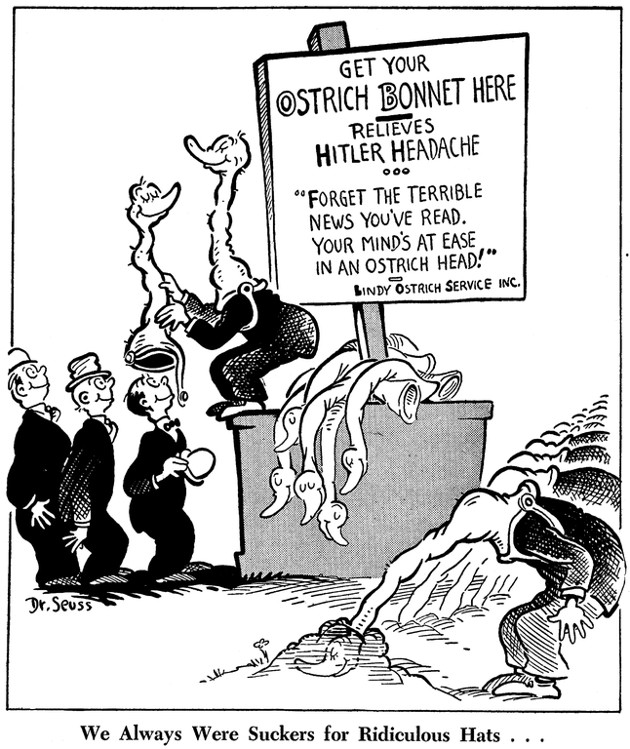
Geisel’s antipathy toward anti-interventionists possibly stemmed from his German-American upbringing in Springfield, Massachusetts, and his circle of friends in New York. Minear told me that in 1976, Geisel wrote a note responding to an interview request from Dartmouth College, saying, “I believed the USA would go down the drain if we listened to the America-First-isms of Charles Lindbergh and Senators Wheeler and Nye, and the rotten rot that the Fascist priest Father Coughlin was spewing out on radio. I, probably, was intemperate in my attacks on them. But they almost disarmed this country at the time it was obviously about to be destroyed.”
Geisel took aim at Hitler and Mussolini, at Lindbergh, and particularly at America First adherents, whom he saw as turning a willful blind eye to the dangers posed by Hitler’s Fascist regime, or even directly associating themselves with Nazism. One cartoon, “The Isolationist,” even featured a limerick, accompanying a drawing of a whale suspending himself “safely” on top of a mountain, out of water, and thus out of danger. It reads, “Said a whale, ‘There is so much commotion/Such fights among fish in the ocean/I’m saving my scalp/Living high on an Alp/(Dear Lindy! He gave me the notion!)”
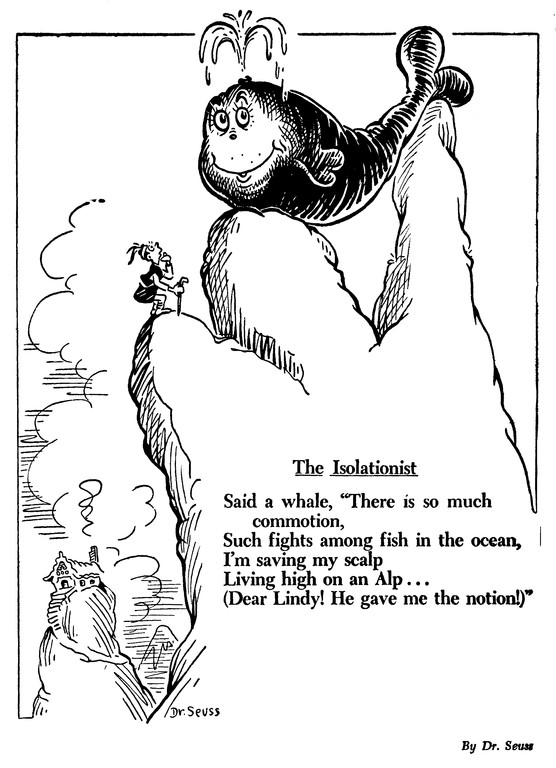
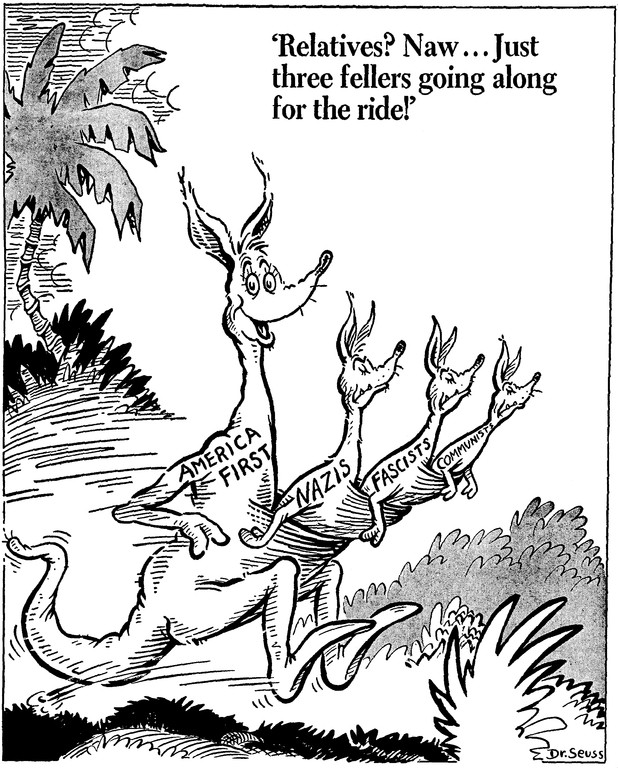
But after Pearl Harbor, Geisel’s cartoons became more overtly opposed to Japan, and more crude in style. He depicted Hideki Tojo, the Prime Minister and Supreme Military Leader of Japan, as an ugly stereotype, with squinting eyes and a sneering grin. In February 1942, he drew a long line of Japanese-Americans on the Pacific Coast of the U.S. collecting blocks of TNT from a kiosk labeled “Honorable 5th Column,” with one pointing a telescope across the ocean. The caption read, “Waiting for a signal from home.”
It’s more than a little baffling now to see Geisel, who’d railed repeatedly against racism, Jim Crow, and anti-Semitism in his cartoons, proffer up such bigoted depictions of Asians both in the U.S. and overseas. “We all have blind spots,” Minear told me. “I use that as a teaching moment—even Dr. Seuss went astray.” In his book, Minear also points out that such sentiment was common in the New York circles Geisel moved in at the time. Although there were reader complaints about drawings he made mocking dachshunds, and the pacifist John Haynes Holmes, there were no letters recorded objecting to his treatment of Asians.
Minear believes, though, that Geisel tried to make up for his earlier prejudice in later works. “Horton Hears a Who came after a trip to Japan, and is easy to read allegorically,” he told me. “The people of Whoville are Japan, Vlad Vladikoff is Russia, Horton is us/democracy, etc.” Geisel supposedly came up with the idea for Horton, in which an elephant discovers a microscopic universe, on a trip to Japan, and dedicated the 1954 book to a Japanese friend. The theme of the story, that “a person’s a person no matter how small,” seems to offer a note of contrition for jingoistic wartime expressions. In the 1980s, too, according to the writer Donald E. Pease, Geisel scanned his earlier books for racial stereotypes, and altered a reference to a “yellow-faced Chinaman who eats with sticks” in And to Think That I Saw It on Mulberry Street.
Horton isn’t the only book that echoes themes explored in Geisel’s political cartoons. Minear thinks that almost all of his later books (with the exception of the ones designed as reading aids) are political in some way or another. The Lorax is an obvious parable about environmentalism. The Sneetches and Other Stories includes an absurd fable about strange yellow creatures, half of whom have stars on their bellies and discriminate against the other half, and vice versa. The Butter Battle Book seems particularly potent today, with its tales of the Yongs and the Zooks, who live on either side of a vast wall, and hate each other because of the different ways they eat their bread and butter. The two sides create increasingly inventive and destructive weapons to fire over the wall until both come up with a device called the Bitsy Big-Boy Boomeroo, which means mutually assured destruction should it ever be fired. The book ends with a standoff, with both sides waiting to see what the other does. It’s a message to children made explicit in what Geisel wanted his last words to be, which he told his biographers, Judith and Neil Morgan, were: “We can and must do better than this!”
Then there’s Yertle the Turtle, a book of stories whose title character is the king of the pond, a ruthless authoritarian who demands that the other turtles stack themselves on top of each other so he can ascend to the top and get a better view. Yertle, who ignores the pain of his underlings, is finally bested by a burp, in a suitably absurd revolution. In the first drawing of him, Minear says, Geisel gave Yertle a Hitler mustache. But now Minear sees another figure in him. Between the narcissism and the arrogance, he says, Yertle “is Trump 50 years ago.”
Little surprise, then, that Geisel’s cartoons, political and non, are finding a new audience now, as protests ramp up against the 45th president, whose affects and actions are at times as recognizable and cartoonish as Dr. Seuss’s characters. It’s hard not to assume Geisel would be cheered by seeing his work inspire signs and memes and viral tweets. “Humor has a tremendous place in this sordid world,” he once said. “It’s more than just a matter of laughing. If you can see things out of whack, then you can see how they can be in whack.”
‘First They Came’: The Poem of the Protests
One of the most striking elements of the protests taking place around the country this week have been the signs—signs that warn, signs that rage, signs that joke, signs that manage, wittily, to do a little of each. Whether scrolled on the sides of old Amazon boxes, or painted in primary colors on brand-new poster board, signs, as tools of protest, function as visual voices: Shared on Snapchat and Instagram and Facebook and Twitter, and captured by professional photographers who send their images to the wire services, they translate the hums of the throngs into language. On Saturday, and again on Sunday, as crowds gathered to protest President Donald Trump’s executive order restricting immigration from seven Muslim-majority countries, signs once again served as speech. Some of the most common read “NO BAN, NO WALL.” Some insisted that “IMMIGRANTS MAKE AMERICA GREAT.” Some noted that “JESUS WAS A REFUGEE.”
Many others, however, quoted the words of a familiar poem—an idea coined by the Lutheran pastor and theologian, Martin Niemöller, in the years following World War II. “FIRST THEY CAME FOR THE MUSLIMS,” the signs start. They add a new ending to the well-worn lines: “AND WE SAID ‘NOT TODAY.’”
A photo posted by @amyschumer on



The specific words of the saying the signs borrowed from vary; the most commonly cited version of Niemöller’s pseudo-poem, however—the one quoted by the United States Holocaust Memorial Museum, as a lyrical manifestation of the evils of political apathy—reads like this:
First they came for the Socialists, and I did not speak out—
Because I was not a Socialist.
Then they came for the Trade Unionists, and I did not speak out—
Because I was not a Trade Unionist.
Then they came for the Jews, and I did not speak out—
Because I was not a Jew.
Then they came for me—and there was no one left to speak for me.
It is a reference to the Holocaust. It is also, however, a warning about the ease with which such an event could occur again, if we of the present allow ourselves to become ignorant of the lessons of the past. Niemöller, born in 1892, was German, and a Protestant. Initially a supporter of Hitler’s rise to power, Niemöller came to oppose him in the years leading up to the war: In 1933, he became the head a group of opposition clergy members, the Pfarrernotbund, or the Pastors’ Emergency League. For that, in 1937, he was arrested and sent to the concentration camps—first to Sachsenhausen and then to Dachau. He survived until the end of the war, when the Allies liberated him and his fellow prisoners. Niemöller returned, after that, to the clergy—and he focused, for the rest of his life, on reconciliation as both a political and a theological aspiration. “First They Came” emerged from that effort.
Niemöller himself resisted the notion that the lines constitute a poem; instead, he said, their ideas came gradually, and organically, through a series of speeches he delivered after the war. One scholar, UC Santa Barbara’s Harold Marcuse, who has studied Niemöller’s diaries, suggests that “First They Came” might have crystallized during a visit Niemöller took to Dachau in November of 1945, mere months after his liberation from the camp. The quotation itself, as it’s used today, Marcuse notes, “most likely emerged in 1946, and it definitely took on the well-known poetic form by the early 1950s.”
And it quickly became popular, from there, as a lyrical argument for civil rights and collective action—and, more broadly, for simple empathy. The quote was that rarest of things: a political argument grounded in religious tradition. As Niemöller explained of the origin of the lines, in 1976 [translated from the German]:
There were no minutes or copy of what I said, and it may be that I formulated it differently. But the idea was anyhow: The communists, we still let that happen calmly; and the trade unions, we also let that happen; and we even let the Social Democrats happen. All of that was not our affair. The Church did not concern itself with politics at all at that time, and it shouldn’t have anything do with them either. In the Confessing Church we didn’t want to represent any political resistance per se, but we wanted to determine for the Church that that was not right, and that it should not become right in the Church ….
In 1933, Niemöller added, he and his fellow clergy members included in the founding documents of the Pfarrernotbund the idea that any action made against a minister of Jewish heritage would be considered an action against the collective. As he put it: “That was probably the first anti-antisemitic pronouncement coming from the Protestant Church.”
What gives “First They Came” such resonance today, though, isn’t merely its warnings about the dangers of apathy or its recognition of what would later be dubbed “normality creep” or, indeed, its lesson on the ease through which the privileged can become the oppressed. The lines’ elegant structure also encourages—indeed, demands—a subjective interpretation. “First They Came” is uniquely malleable: a 20th-century poem that reads as almost tailor-made for the remix culture of the 21st. It features an almost fill-in-the-blank format, suggesting both hyper-personalization and omni-relevance. It is no surprise, in that sense, that its structure has been adopted by everyone from James Baldwin (“If they come for me in the morning, they will come for you in the night”) to union activists (“First they came for McDonald’s…”).
“First They Came,” in other words, is particularly attuned to the needs of the modern protest: It offers wisdom about the evils of the past, in an attempt to prevent more evils of the future. To use its language is to claim an understanding of history—and an understanding, too, of how readily its mistakes can be repeated by those who fall victim to the luxuries of forgetfulness. It is #neveragain, and #neverforget, with the subjects added in. It is a poem made powerful by its pronouns: They-I-I, They-I-I, They-I-I, They-no one-me.
Harold Marcuse, for his part, warns that remix was likely not Niemöller’s intention when he used his warnings as a refrain. “Niemöller’s original argument was premised on naming groups he and his audience would instinctively not care about,” Marcuse writes. “When his poem is invoked today it is usually to add one’s own group to the list of persecuted. That was not a meaning that Niemöller ever wished to convey.” It’s an objection, however, that could prove the rule: “First They Came,” as used today, derives its power from the notion that no one should be instinctively not cared about—that everyone is deserving of attention and, indeed, protection. That is the nature of politics, and of compassion. And it is to our peril, the poem suggests, that we forget how wound and woven we all are, in the end. They-I-me: The great promise—and the great threat—is, the poem warns, that they will prove to be the same.
On Being N.E.D.
A.NSo am I “ok now”? I bristle a little, I admit, at the well-meaning line of inquiry, for the way it places on the patient the burden of reassurance: the duty to confine cancer to the hermetic province of the past. What I hear in this question is prudent circumspection; what I hear is this: will I need to invest undue emotional energy in you? Will I need to grasp as more than mere abstraction the fact of your sickness, your death?
This is an “On Being” essay. An “On Being” essay is an assignment I give my students: part personal narrative, part critical analysis. Narrative, because your lived experience matters; analytical, because to investigate and challenge that experience is to make it meaningful. I teach courses in the medical humanities, courses on health, illness, disability, and embodiment. I bring my training in literary and cultural analysis to the classroom. And I bring this training to my body, and my body to the classroom, too.
I was diagnosed with invasive breast cancer at the age of 24. When people learn this, they often ask something like: “But you’re okay now, right?” And most of the time I offer a nod of cheerful confidence, though I frequently re-frame the terms of assessment: “I’m okay for now,” I say.
Remission is tricky. In the case of many cancers, the five-year mark is commonly held as a significant milestone; five years sans recurrence, and your cancer can be considered in remission. But the research surrounding breast cancer survival rates points to the fallacy of fetishizing the oft-touted five-year all-clear. What’s more, this research mainly concerns postmenopausal women; no significant longitudinal data yet exists to assess the survival rates of women diagnosed in their twenties and thirties, whose cancers tend to be more aggressive, less responsive to treatment, and diagnosed at later stages. All that we know, then, is that you can never really know if you are over it. The possibility of recurrence and metastasis continues to linger ten, fifteen, even twenty years post-diagnosis. So you exist — persist — under receding, but nevertheless constant threat.
But no one wants to hear that.
Remission is polysemic. Etymologically, it signifies forgiveness; as a lapsed Catholic, I ought to know this. I have spent requisite Sundays affirming belief in the forgiveness of sins: remissiónem peccatórum. So from what or from whom are we cancer “survivors” meant to seek absolution? Most obviously, it would seem, from those white-coated ecclesiastics who serve as intermediaries between us and Science — those privileged custodians of knowledge who assume the responsibility of rendering us legible to ourselves.
But biomedicine’s limited omniscience —its inability to forecast the course the body’s story with precision — suggests that we also seek absolution from the disease itself, granting it agency and intentionality, making recourse to the metaphorization of illness that Sontag identified as politically fraught. Sinners in the hands of an angry bod.
***
Like any site of discourse, the oncology ward has its Shibboleths. In lieu of remission, with all of its sectarian overtones, oncologists tend to favor the more enigmatic appellation N.E.D: “no evidence of disease.” (A group of gynecological surgeons has adopted this as the name of their rock band. The band’s devotees—middle-aged white women, mainly—refer to themselves as “NED-heads”). As a classification, “N.E.D.” is appropriately clinical, suggesting that one’s condition is assessed in terms of the evidence biomedical technology affords us. And it is also appropriately hedging: after all, just because it isn’t “evident” doesn’t mean it isn’t there.
As a professor, I spend a considerable amount of time explaining and assessing the concept of “evidence.” Given that my field of specialization is inherently interdisciplinary, I must unpack for my students what counts as evidence according to the dictates of disciplinary conventions. In the sciences, for example, we emphasize empirical evidence above all else — evidence that is verifiable by observation, gathered in accordance with the ordinances of the scientific method, and replicable by trial.
For students who take comfort in this model, the evidence of humanists often seems especially suspect. But I was trained as a literary historian; the primary genre of evidence I dally with is textual: what is said and how, and also what is unsaid, what is hiding inside silences and under surfaces. This understanding of evidence calls us not only to observation but to analysis. And it invites us, in ways the “hard sciences” typically do not, to consider the evidence of lived experience, to treasure the evidence of feeling.
For physicians, of course, what is meant by “evidence” is that which is rendered visible by diagnostic imaging or perceived during physical examination. This leaves open the possibility that evidence of disease may exist, but in forms that are unknown or unknowable by accepted methods and metrics of assessment. After all, most of what goes on in our bodies lies below the threshold of perception. As a consequence, we cling close to the rhetoric of “early detection,” believing that, if we are unable to witness that first errant cell division by which cancer comes into being — the pathological process known as “carcinogenesis” or “oncogenesis” — then we might at least head it off at the pass; that if we cannot know our bodies at a cellular level, we might compensate with a kind of somatic hyper-attentiveness.
We expect medicine to mitigate the anxiety of opacity by affording us a transparency of which it is more often than not incapable. This charge is turned back upon us under the mantle of “awareness,” as we’re saddled with the task of becoming on intimate terms with our bodies, primed to identity the subtlest of anomalies. Self-examination as self-revelation.
Of course, I am keenly aware how crucial self-examination has been and is to the women’s health movement in particular, which has sought to redress the problems wrought for generations of women kept by propriety from the mysteries of their own interiors, who suffered silently from preventable and treatable diseases, symptoms of our wider cultural gynophobia. The very fact of female embodiment has scared us shitless for millennia.
So self-examination gives us agency, yes, but it also gives us anxiety, because it is not enough to simply gather a somatic data-set; we must also be qualified to interpret that evidence, or, more precisely, to assess whether that evidence is evidence. We need the epistemological privilege of medicine in order to be able to say what counts about our own bodies. This is a burden for everyone and all patients, but it is a weight that falls especially heavily on women, since we are routinely denied — culturally, legally, institutionally —the ability to speak with authority about our own lived experience.
***
What is important to know about being N.E.D. is that I am not afforded the full repository of biomedical technology that would most accurately identify “evidence.” Or as my oncologist puts it: “We don’t go looking for trouble.” While I have annual mammograms of my remaining breast because I am at an increased risk of developing second primary cancer, all the other recesses of the body where the original cancer might metastasize (liver, lungs, bones, brain) remain untrodden territory, shrouded in diagnostic darkness. Blood tests for tumor markers are unreliable; CT and PET scans aren’t on the menu for the asymptomatic.
Supposedly, such metastatic symptom-seeking would be merely be panic-producing for patients like me, who are already in constant pursuit of confirmation of our darkest fears, producing suspicious readings of our own bodies; more to the point, though, diagnostic imaging is expensive, and it isn’t worth hunting for the incurable. Ignorance is, if not bliss, then the clear conclusion of a cost-benefit analysis.
As far as I can tell, metastasis is held as self-evident: you’ll know it when you see it. Or feel it, I guess. You must wait until the presence of death is too obvious to be ignored. Accordingly, every sensation gets assimilated into a complex system of self-diagnostics, spawning midnight questions typed into search engines and online discussion fora: What do lung mets feel like? What do bone mets feel like? And any answer is distanced by the impetus to simile: these things do not feel “like” anything.
***
So am I “ok now”? I bristle a little, I admit, at the well-meaning line of inquiry, for the way it places on the patient the burden of reassurance: the duty to confine cancer to the hermetic province of the past. What I hear in this question is prudent circumspection; what I hear is this: will I need to invest undue emotional energy in you? Will I need to grasp as more than mere abstraction the fact of your sickness, your death?
But to be N.E.D. is to nurse this uncertainty. Suspended in my body, in my being, is the expectant question I also scrawl, with purple pen, in the margins of my students’ essays:
“Evidence?”
Emily J. Waples: Okay for now.
#938: Supporting Immigrant Coworkers in the USA.
Hi,
I have a coworker from Iran. The President is about to announce awful policies around admitting people from countries including Iran. I’m pretty sure he and his siblings are all here on non-permament statuses, though I don’t know for sure. He’s a friendly acquaintance, not someone I’d say I have a close relationship with, but it’s a small workplace and we’ve talked a fair bit.
Is there a good way to be supportive and express solidarity? I don’t want to put him on the spot, as questions that make him uncomfortable, etc. But I do want to do anything I can to make him feel better or make things actually better for him, be that being an emotional support in these stressful times, just letting him know that people around him care, or something else. For context, we live in a very liberal major city in a liberal industry, in a company where people openly talk about their distress over the current political situation, so he probably assumes people are generally on his side.
Thank you.
Hello everyone, it’s the week that the U.S. government decided to use Holocaust Memorial Day to drop a bunch of evil, racist, discriminatory, xenophobic (not to mention illegal) rules designed to cause as much terror and chaos as possible for vulnerable people. Fun fact: The Executive Order in question (full text here, but also potentially hearing That Voice talking in autoplay video, so, be warned) also affects legal permanent residents (green card holders) and dual citizens of other countries (for example, if you are a French citizen who was born in one of the targeted countries, you could also be turned back from boarding a plane or detained at airports) and is designed to create maximum tension & upheaval for people who are already “vetted” and in the country legally. It is already causing chaos and despair for people I personally know and love, and even though initial legal challenges are working and there have been some temporary stays, it is just the beginning of what the new administration has planned with its Nazilicious “America First!” policies where people can be made “illegal” with the stroke of a pen. If you’re in the USA and you’re reading this and think this was a great idea or want to tell me how it isn’t that bad or we should give it a chaaaaaaaaance, please kindly fuck off forever from this website. First rule of surviving an autocracy: Believe the autocrat. It is that bad.
Related reading: 1. Mrs. Kirkorian, Sharon Olds, 2. Home, Warsan Shire.
Hello, Letter Writer, thanks for writing your sadly- timely-as-fuck letter and wanting to do right by your coworker.
The literal best thing you can do right now is to help stop the policies (Source: The Nation).
A. Educate *yourself* about the issue. Don’t make already-vulnerable people explain things to you and for fuck’s sake if they do explain things, don’t debate them about it or try to correct them about it and don’t offer empty reassurances that it can’t be that bad. A lot of smart people are writing about this stuff right now, you can hold your questions until you can be alone with Google and those critical thinking skills you were hopefully taught in school. You don’t have to become the world’s foremost expert or be debate-team perfect overnight. If your coworker wants to talk about stuff, listen without interrupting.
B. Bug every single elected official that you have, every day. Here are tips for doing so if you have anxiety. Short version: Calling works best. If you’re going to send postal mail, use postcards. Call YOUR representatives. Say your name and address and keep it short. Be nice to the person answering the phones, they have a hard job. Script: “Hi my name is ___ and my address is _____. I don’t need a response.* I do not support ____ and am asking Senator ____ to vigorously oppose it” or “I want to thank Senator ____ for their action/vote/position/statement on _____ issue.” Pick one issue per call (this is the hardest part, honestly).
I hated doing this at first but now it takes me about 15 minutes a day, all told.
*Saying “I don’t need a response” makes it faster for the staffers to deal with you b/c they don’t have to add you to the list of people who need a physical letter.
C. Support organizations doing the work. The ACLU is a worthy organization working hard on this, but they aren’t the only ones. From The Nation:
4. ACT LOCAL: JOIN GRASSROOTS EFFORTS AND INITIATIVES
Many of the efforts protecting immigrants will be on the local level, so find the groups in your community doing the work. As with most small nonprofits, donations are always welcome, but if that’s not within reach, take time to learn about the organization, its active campaigns, and volunteer your time. Below are a few examples to get you started.
Arab American Association of NY (AAANY): AAANY supports and empowers the Arab Immigrant and Arab American community by providing services to help immigrants adjust to new homes and become active members of society. Their aim is for families to achieve the ultimate goals of independence, productivity and stability.
National Day Laborer Organizing Network (NDLON): NDLON works to improve the lives of day laborers in the US. With member organizations across the country, NDLON works to unify and strengthen its base in efforts to develop strategic and effective leadership, mobilization and organizing campaigns.
CAIR: The Council on American Islamic Relations has fought for the civil rights of American Muslims. There are 30 nationwide affiliates, defending, representing, and educating over 1 million Muslims in the New York area.
Families for Freedom (FFF): FFF is a multiethnic human-rights organization in NYC run by and for individuals and families facing and fighting deportation. FFF organizers are immigrant prisoners, former prisoners, their families, or those at risk of deportation. Their aim is to empower immigrant communities as communities of color, and to be a guiding voice in the fight for human rights.
Grassroots leadership: Located in Austin, Texas, Grassroots Leadership believes “no one should profit from the imprisonment of human beings” and they “work for a more just society where prison profiteering, mass incarceration, deportation, and criminalization are things of the past.” They are currently organizing Sanctuary in the Streets Training to build sanctuary networks through direct action and organizing throughout Texas.
Hebrew Immigrant Aid Society (HIAS): HIAS brings the lessons of its history and Jewish ethics and experience to our commitment to serve refugees and other displaced persons of concern around the world through the following values: Welcoming, Dignity and Respect, Empowerment, Excellence and Innovation, Collaboration and Teamwork, and Accountability. If you’re not in New York, HIAS also works with a variety of refugee resettlement organizations across the country.
Make the Road New York (MRNY): MRNY builds the power of Latino and working-class communities to achieve dignity and justice through organizing, policy innovation, and transformative education. Its campaigns include expanding civil rights, promoting health, improving housing, achieving workplace justice, improving public education, and empowering youth. It has recently launched a group called Aliados for allies of immigrants to join the fight. You can sign up for their next meeting here.
Many of these are NYC-central; you very probably almost definitely have a group somewhere local to you. The awesome airport protests yesterday didn’t happen “out of nowhere.” It’s great that social media reached so many people and got them to show up, but many brave people were organizing for this eventuality already. Connect.
D. If you can protest/march/rally/show up where you are, then do it. If you can’t, and not everyone can, do what you can to support those who can. For one example, I like the Chicago Community Bond Fund, which helps pay bond for people who can’t afford it, including but not limited to protestors and civil rights activists. Make signs. Make calls. Provide child care for people who go.
Use your voice and your power as a citizen to fight this. This is not so much “resistance” as the work of civic engagement we should all have been doing all along.
E. Beware of dogwhistles. I listened to the UK Prime Minister – US President press conference on Friday (why I did this to myself I don’t know but I did) and the number of times they used the term “ordinary working people” or “ordinary working citizens” in their comments was telling. Whatever else those words mean when they are at home, when politicians use them together it is a code that specifically means”white people who hate foreigners and who are probably racist, like me.” Every time you hear Real Americans or Ordinary Working People or The White Working Class from a politician, you are hearing a racist dogwhistle. Every time. I don’t care who is saying it – If your preferred-lefty-sort-of-candidate or politician is saying it, it’s still a racist dogwhistle used when trying desperately to chase after those voters.I say this because another racist dogwhistle is about “peaceful protesters” versus the other kind. We’re seeing bills to criminalize protest pop up all over the place. The Women’s Marches last weekend were “peaceful” because the police did not meet large groups of white women with the same violence and attempts to provoke violence that they routinely visit on black protestors. If you want people to continue to be able to demonstrate in defense of their human rights in our country, white people gotta show up and keep showing up for black activists, immigrants, Native American/First Peoples, and others.
Learn to hear these dogwhistles for what they are and call them out. We’re going to hear them a lot in these coming years.
F. Bonus: If you’re in a position to do something on an institutional level, do it. Companies who depend on international workers, what can you do to sponsor visas/hire attorneys/throw emergency funds to people in crisis/pull some levers of power for your employees? If you’re not in management, that’s a good question for you and coworkers to ask management. “Hey, what is company doing to support our colleagues and help them defend their rights? And how can we help?” (P.S. Wealthy people who hire domestic workers, what are you doing to keep your staff safe right now?)
G. Actually talk to your coworker.
Okay. You did some reading. You’ve called your representatives and will keep calling them. You donated some $ and some time. You deleted or countered the dogwhistle comments from that one racist relative on your Facebook. Maybe you showed up at an airport or are gonna show up soon to witness and protest for detainees. Cool. Then it’s time to say to your coworker something like, “I can’t imagine how stressful and terrifying all of this is for you & your family. I don’t agree with it and I’m doing what I can to stop it. I don’t want to put you on the spot, but I wanted to tell you that I’m really glad you’re here and that I get to work with you and know you.”
Remember, “Comfort In, Dump Out.”
Remember also that “Let me know if there’s anything I can do” is not actually a helpful thing to drop on someone in crisis. It feels helpful, but actual help needs to be more specific. More helpful would be “If you need to vent about it, I’m happy to listen.”
If we all do the work diligently and for real maybe we can avoid the “If you need me to hide you in my attic for several years, I’m down” stage.
I’ve got some heavy deadlines and distractions going on, so I’m turning comments off for this post. Google. Call. Donate. Demonstrate. Question. Be kind.
Calling Out a Presidential Lie
People lie. Yes, even presidents lie. Especially presidents, you might argue. And yet there’s a long history in journalism of being very, very careful about saying so.
There are excellent reasons for this standard.
Descriptions like “claimed without evidence,” “falsely said,” and “wrongly asserted” are clunky, but they also avoid explicitly describing intent. Same goes for “untruth,” “falsehood,” and “unsubstantiated claim.” Calling something a “lie” implies that the speaker knows what he said is untrue, and that he meant to deceive. (A similarly classic—and often-broken—rule in journalism is to avoid saying what someone believes. You can describe what they say they believe, the thinking goes, but there’s no way to know what someone actually believes unless you are that person.)
Questioning a sitting president’s truthfulness and actually using the words “lie,” “lied,” or “lying” has often been relegated to the opinion pages, editorials, or put in quotation marks: Let somebody else suggest the chief executive is lying about Yalta, or Cuba, or Vietnam, or trading arms for hostages, or “no new taxes,” or sexual relations with that woman, or weapons of mass destruction. This is the stuff of standard journalistic fairness.
The standard, however, is coming under pressure.
Not just by the bombastic new president of the United States and his famous tendency to exaggerate, but by that president’s embrace of new-age publishing technology—you may have heard, the guy loves to tweet—and his over-the-top disdain for journalism at a frenetic moment for the media industry.
Newsrooms have wrestled with how to characterize the misinformation Donald Trump spreads since the presidential campaign, when his eyebrow-raising statements tended more toward “pants on fire” than true, according to at least one fact-checking site. This challenge is only intensifying with Trump in the Oval Office, and backed by an administration eager to provide “alternative facts” when the actual facts don’t flatter the president.
Trump has been embroiled in so many disputes over truth that it’s difficult to know where to begin. “If falsehood, like truth, had only one face, we would be in better shape,” the philosopher Michel de Montaigne famously wrote. “But the reverse of truth has a hundred thousand shapes and a limitless field.”
So let’s start with voter fraud.
In a private meeting with Congressional leaders this week, the president doubled down on the claim—the falsehood, the untruth, the unsupported notion, the you-get-the-idea—that millions of people voted illegally in the November election, costing him the popular vote.
There is no evidence to support this extraordinary claim. But news organizations differed in how to make that clear. Here’s a sample of headlines from around the media (asterisks indicate publications that used the Associated Press story and headline):
ABC News: “Fact-Checking Trump's Repeated Unsubstantiated Claim of Widespread Voter Fraud”
The Atlantic: “The White House Clings to False Claims of Massive Voter Fraud”
Breitbart: “Trump Believes ‘Millions’ Voted Illegally: White House”
Associated Press: “Trump wrongly blames fraud for loss of popular vote”
BuzzFeed: “Trump Falsely Claims Millions Voted Illegally, Costing Him The Popular Vote”
The Chicago Tribune: “Trump falsely tells congressional leaders that millions of illegal ballots cost him popular vote”
CBS News: “Trump claims 3-5M illegal ballots cost him popular vote, cites no evidence”
CNN: “Trump believes fraud cost him popular vote”
Fox News: “Trump tells Congressional leaders 3-5 million 'illegals' cost him popular vote”
*The Houston Chronicle: “Trump wrongly blames fraud for loss of popular vote”
The Hill: “Trump continues to insist voter fraud robbed him of popular vote”
NBC News: “Trump Again Makes Debunked Claim: ‘Illegals’ Cost Me Popular Vote”
The New York Times: “Trump Repeats Lie About Popular Vote in Meeting With Lawmakers.”
New York magazine: “Trump Repeats Lie That Millions Voted Illegally in Meeting With Congressional Leaders”
New York Daily News: “President Trump still pushing unconfirmed claims that voter fraud cost him the popular vote”
New York Post: “Donald Trump brings up bogus voter fraud claims — again”
NPR: “Trump Still Insists Millions Voted Illegally. (There's Still No Evidence Of That).”
Politico: “Trump repeats debunked voter fraud claim at meeting with Hill leaders”
Roll Call: “Trump Announces Federal Voter Fraud Probe Amid Questionable Claims”
*San Francisco Chronicle: “Trump wrongly blames fraud for loss of popular vote”
The Wall Street Journal: “Donald Trump Repeats Unsupported Claim That Voter Fraud Skewed Election Tally”
The Washington Post: “Without evidence, Trump tells lawmakers 3 million to 5 million illegal ballots cost him the popular vote”
The Washington Examiner: “Trump tells top lawmakers 3-5 million illegals voted in election”
NPR got considerable attention for its editorial judgment when it was revealed that the network “has decided not to use the word ‘lie,’” in its coverage of Trump. As soon as “you start branding things with a word like ‘lie,’ you push people away from you,” the network’s senior vice president for news told a colleague. So NPR went with this headline: “Trump Still Insists Millions Voted Illegally. (There's Still No Evidence Of That).”
The New York Times, with the blessing of the paper’s executive editor, went with a bolder framing: “Trump Repeats Lie About Popular Vote in Meeting With Lawmakers.” (Notice, though, that the paper didn’t say Trump lied; they called his claim a lie.) Dean Baquet, the paper’s top editor, told a Times reporter that “he fully understood the gravity of using the word ‘lie,’ whether in reference to an average citizen or to the president of the United States” and that he “emphasized that it should be used sparingly, partly because the term carries such negative connotations, and partly so that it does not lose potency.”
For those who pay close attention to the Times, the use of “lie” this way is indeed striking—but it isn’t surprising. During Trump’s campaign, Baquet described why the Times was comfortable referring to Trump’s conspiracy theory about Obama’s birthplace as “the birther lie” in this headline of a story published in September, after Trump finally acknowledged Obama was born in the United States: “Donald Trump Clung to ‘Birther’ Lie for Years, and Still Isn’t Apologetic.”
“I think to say that that was a ‘falsehood’ wouldn’t have captured the duration of his claim, to be frank, the outrageousness of his claim,” Baquet told NPR in an interview at the time. “I think to have called it just a falsehood would have put it in the category of, to be frank, ‘usual political fare,’ where politicians say, ‘My tax plan will save a billion dollars,’ but it’s actually a half a billion and they're using the wrong analysis. This was something else. And I think we owed it to our readers to just call it out for what it was.”
So what was it, really, when Trump claimed this week that millions of people voted illegally in November? Or when he made the same claim in a tweet late last year?
To BuzzFeed, which is keeping “A Running List Of All Of President Trump’s Lies,” it was a lie. BuzzFeed News reported that Trump “lied about voter fraud at a reception with congressional leaders” and again “lied about voter fraud on ABC News.”
In addition to winning the Electoral College in a landslide, I won the popular vote if you deduct the millions of people who voted illegally
— Donald J. Trump (@realDonaldTrump) November 27, 2016
“Clearly, he thinks it is true,” wrote one person in a letter to the Times this week, “So it’s not a lie; it’s a delusion.”
But even a delusion—one that involves blindly turning away from all evidence to the contrary—can be considered its own kind of lie. That’s what David Corn, the author of The Lies of George W. Bush, told The Atlantic in 2007: “What Bush does is that he displays a kind of willful disregard for the truth, which is the moral equivalent of lying,” Corn said, referring to then-president George W. Bush. “He doesn’t do any due diligence with the facts. Even if you believed something was true [at] the time you said it, it becomes a lie when you don’t act on new information—or correct yourself when you’ve been proven wrong.”
Corn’s description fits with Trump’s insistence on voter fraud, and with his disposition generally. Trump likes to call out others for being wrong—he relishes “wrong!” as one of the many insults he lobs in tweets—but he is not one to acknowledge his own mistakes.
"@aaronrupe33: @realDonaldTrump no ones scared of you donald" You are very wrong!
— Donald J. Trump (@realDonaldTrump) May 24, 2013
He also routinely criticizes people by calling them liars. He bestowed the nickname “Lyin Ted” on his one-time political opponent Ted Cruz. And Trump has cultivated an image of brusqueness that his supporters sometimes equate with honesty—taking the idea that he isn’t afraid to say what he thinks as proof that what he says is necessarily true.
If Obama was willing to lie about ObamaCare then what else has he lied to us about…
— Donald J. Trump (@realDonaldTrump) October 30, 2013
Tweets are instructive here, both because of how they illustrate Trump’s style and as a reminder that Trump’s presidency is taking place in a media environment unlike any that preceded it. Obama is known for his social media proficiency, but Twitter was still brand new when he was first inaugurated.
No president in history has lied to the American people more than President Obama - in fact, it is not even close!
— Donald J. Trump (@realDonaldTrump) June 8, 2014
And though Trump is known to be a devoted consumer of print newspapers and cable news, people are increasingly turning to the mobile internet for information. Trump has said he sees his Twitter account as a megaphone directly to the people, and he doesn’t hesitate to scream into it. For those who pay attention to Trump’s tweeting, there’s an entire flood of people calling him a liar in his mentions—a feed that can be considered its own micro-media environment, and one that has a massive audience.
Meanwhile, in the crowded and information-rich wilds of the internet, the news cycle is as close to “real time” as technology has ever allowed it to be. “Fake news” isn’t a new concept—there was a fake news crisis in the 19th century—but the pace of the news and the scale at which hoaxes can be made and distributed is certainly a complicating factor. Traditional media gatekeepers haven’t just lost their monopoly on publishing and distribution technologies—they’ve lost institutional prestige and public trust. The loss of cultural influence among the American press benefits the Trump administration, which is clearly focused on attempts to goad reporters. “I want you to quote this,” Steve Bannon, Trump’s top White House strategist and the former chairman of Breitbart News, told The New York Times on Wednesday. “The media here is the opposition party.” Trump himself encourages the denigration of American journalism twofold: he criticizes legitimate news organizations as “fake,” and he pushes sensational claims from fringe sites.
“The pragmatic problem with official lies is their amoeba-like penchant for self-replication,” writes Eric Alterman in his book, When Presidents Lie. “The more a leader lies to his people, the more he must lie to his people.”
“Lying may appear to work for a president in the short term and, in many cases, it does,” Alterman says. “But a president ignores the consequences of his deception at his own political peril.”
If this is a problem for Trump, he seems unbothered by it. So far Trump appears far more interested in holding news organizations accountable.
With frequent dialogue among editors, reporters, and readers on social platforms, and with sites like NewsDiffs—which tracks how online articles are edited by showing side-by-side comparison of changes—scrutinizing the press is possible like never before. The internet has given news consumers a more privileged view of how journalism is produced: They can see how new information is added, the social context around corrections appended, and follow conversations about when and why headlines are tweaked. The business of news gathering is, at its core, a mission of truth seeking—and it’s a messy one. Trump, for his part, seems less interested in journalistic nuance and more concerned with coverage that offends his ego. So concerned that, in the 1980s and 1990s, he was known to call journalists and pretend to be a publicist named John “vigorously defending” Trump, as The Washington Post put it. The Post described that stunt as masquerading, not lying, for what it’s worth.
Today, the challenge of figuring out what is real—and often doing so before an audience in real time—is why journalists must be careful, as ever, with facts and words. Fairness matters. But so do accuracy and credibility. Which is why it’s just as important for journalists to call a lie “a lie” when they hear one.
Trump may have won the presidency, but he’s now fighting for his legacy. He’s also declared himself to be “in a running war with the media,” at a time when the journalism industry is in its own battle for survival. The stakes are high all around. But if journalists are up for a fight, it’s not because Trump called them “the lowest form of life,” or because his chief strategist said the news media should “keep its mouth shut.” In journalism, the fight is to hold the powerful accountable; to seek truth and report it.
President Trump seems to be banking on the idea that facts don’t matter. But presidential history, a history told first in front pages, tells us otherwise.
Creamy Black Bean Taquitos
So apparently the Super Bowl is coming up soon? I dunno. I don’t follow football, but I know a lot of you do, so I wanted to give you some budget-y options for football eats! These cute and crispy little Creamy Black Bean Taquitos are really easy, fun to eat, and are totally Super Bowl worthy. Plus, they make a pretty impressive presentation, especially when provided with multiple sauces for dipping.
Making a vegetarian taquito means that almost all the ingredients are very budget friendly. Corn tortillas are super cheap, especially when you buy a large pack. If you can’t use 30+ corn tortillas at once, you can freeze half of them or just use the other half to make some homemade baked tortilla chips. Because it isn’t a party without some tortilla chips anyway, right? You can also cut the cost significantly by using beans that are cooked at home instead of canned. I’m out of my home cooked beans right now, so I had to use canned, but home cooked are usually about 1/3 the cost for me. Here’s a tutorial on how to cook beans easily using a slow cooker.
These taquitos are great on their own, but it’s always fun to have something to dip them in. I like salsa for these because the filling is already creamy, but sour cream or guacamole are also nice!
Goes great with: Cowboy Caviar, Warm Corn and Avocado Salad, Fire Roasted Salsa, Best Ever Avocado Dip
Creamy Black Bean Taquitos

- 4oz. cream cheese (room temperature) $1.00
- 15oz. can black beans $0.95
- 4oz. can diced green chiles $1.09
- 2 green onions $0.21
- 2-3 dashes hot sauce (optional) $0.05
- ⅛ tsp garlic powder $0.02
- ⅛ tsp salt (or to taste) $0.02
- 15 6-inch corn tortillas $1.37
- 3 Tbsp cooking oil, divided, for frying $0.12
- Rinse and drain the black beans. Drain the diced green chiles. Slice the green onions. Add the cream cheese, black beans, green chiles, green onion, hot sauce, garlic powder, and salt to a bowl. Stir together until evenly combined, then taste and adjust the salt or hot sauce to your liking.
- Stack 5 tortillas on a plate, cover with a damp paper towel, and microwave for about 20 seconds to soften (this helps prevent them from cracking when rolled). Heat a large non-stick or cast iron skillet over medium heat. Working quickly as the skillet heats, place about 2 Tbsp of the black bean filling in each tortilla then roll tightly closed.
- Once all five are filled, add about 1 Tbsp cooking oil to the skillet, give it a few seconds to heat (it should shimmer), then add the filled taquitos seam side down. Cook the taquitos on each side until brown and crispy, then transfer to a clean plate.
- Repeat the process in small batches of five, adding a little more oil to the skillet each time, until all the filling has been used (about 15 taquitos). Serve while still hot.


Step by Step Photos
 Start by rinsing and draining a 15oz. can of black beans (or 1.5-2 cups if using homemade). Drain one 4oz. can of diced green chiles. Add 4oz. room temperature cream cheese to a bowl with the black beans, green chiles, 2 sliced green onions, 2-3 dashes of hot sauce, 1/8 tsp garlic powder, and 1/8 tsp salt.
Start by rinsing and draining a 15oz. can of black beans (or 1.5-2 cups if using homemade). Drain one 4oz. can of diced green chiles. Add 4oz. room temperature cream cheese to a bowl with the black beans, green chiles, 2 sliced green onions, 2-3 dashes of hot sauce, 1/8 tsp garlic powder, and 1/8 tsp salt.
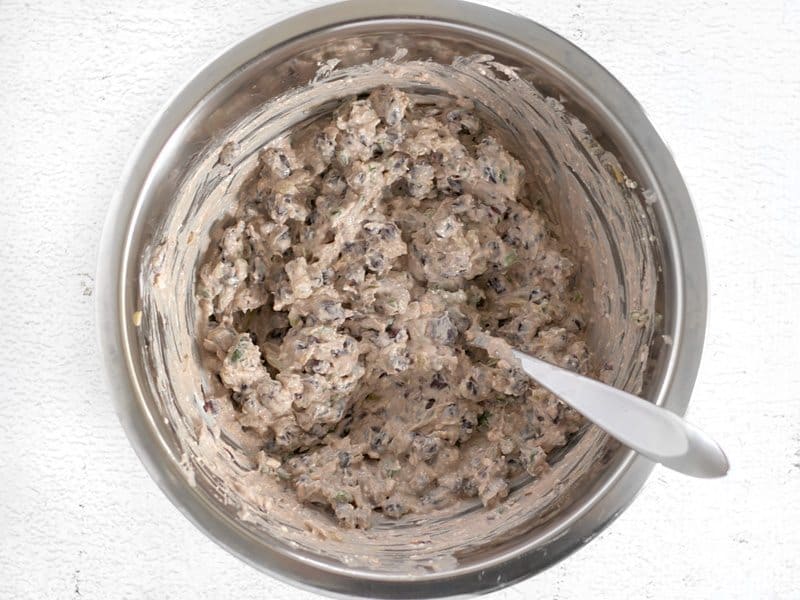 Stir everything together until well combined. Taste the mixture and adjust the salt or hot sauce to your liking. The mixture isn’t very pretty, I’ll admit, but it’s SO tasty!
Stir everything together until well combined. Taste the mixture and adjust the salt or hot sauce to your liking. The mixture isn’t very pretty, I’ll admit, but it’s SO tasty!
 Working in small batches of about 5 tortillas at a time, place the 6-inch tortillas on a plate, cover with a damp paper towel, and microwave for about 20 seconds to soften them up some. This helps them stay pliable and not crack open when you roll them.
Working in small batches of about 5 tortillas at a time, place the 6-inch tortillas on a plate, cover with a damp paper towel, and microwave for about 20 seconds to soften them up some. This helps them stay pliable and not crack open when you roll them.
 Begin heating a non-stick or cast iron skillet over medium heat. Working quickly, begin filling each tortilla with about 2 Tbsp of the black bean filling, then rolling tightly. You’ll need less filling than you suspect, I promise. You want the tortilla to wrap around itself at least once, so don’t over fill.
Begin heating a non-stick or cast iron skillet over medium heat. Working quickly, begin filling each tortilla with about 2 Tbsp of the black bean filling, then rolling tightly. You’ll need less filling than you suspect, I promise. You want the tortilla to wrap around itself at least once, so don’t over fill.
 Once the skillet is hot, add about 1 Tbsp cooking oil and swirl to coat the surface. Give it a couple of seconds to heat until it looks shimmery, then add the rolled taquitos seam side down. Let the taquitos cook on each side until golden brown and crispy. Keeping them close together as they cook also helps prevent them from unrolling while in the skillet. You can use the few minutes while they cook to start warming, filling, and rolling the next batch of taquitos. Repeat the process in small batches, adding a little more oil to the skillet each time, until they’re all filled and cooked.
Once the skillet is hot, add about 1 Tbsp cooking oil and swirl to coat the surface. Give it a couple of seconds to heat until it looks shimmery, then add the rolled taquitos seam side down. Let the taquitos cook on each side until golden brown and crispy. Keeping them close together as they cook also helps prevent them from unrolling while in the skillet. You can use the few minutes while they cook to start warming, filling, and rolling the next batch of taquitos. Repeat the process in small batches, adding a little more oil to the skillet each time, until they’re all filled and cooked.
 And that’s how you make super simple, delicious, crispy, and creamy black bean taquitos!
And that’s how you make super simple, delicious, crispy, and creamy black bean taquitos!
The post Creamy Black Bean Taquitos appeared first on Budget Bytes.
The Conspiracy Theorist in the White House
While losing the Electoral College, Hillary Clinton earned roughly 3 million more votes than President Donald Trump during the 2016 presidential election. And he cannot stand it.
Trump drew widespread, warranted criticism Tuesday for his repeated, false claim that the November election was compromised by fraud on the order of millions of votes, a claim made all the more surreal by the fact that Trump actually won the election he’s complaining about, alongside Republican majorities in both the House of Representatives and Senate.
The irresponsible falsehood caused Jake Tapper to declare on CNN Tuesday night that if the president really believes America’s entire election system was so thoroughly compromised, he would be duty bound to investigate the matter and fix the problems, rather than erratically complaining about them in arbitrarily timed rants. Of course, Tapper repeatedly noted, there is absolutely no evidence for Trump’s claims.
On Wednesday morning, as if in response to CNN, Trump said this on Twitter:
I will be asking for a major investigation into VOTER FRAUD, including those registered to vote in two states, those who are illegal and....
— Donald J. Trump (@realDonaldTrump) January 25, 2017
even, those registered to vote who are dead (and many for a long time). Depending on results, we will strengthen up voting procedures!
— Donald J. Trump (@realDonaldTrump) January 25, 2017
Unfortunately, there is precedent for Trump fixating on a falsehood for years on end, doubling and tripling and quadrupling down, despite an utter lack of evidence, and then, upon finally beginning to acknowledge that his inane allegations were unfounded, asserting that we should really be thanking him for his efforts.
Here is that precedent:
Made in America? @BarackObama called his 'birthplace' Hawaii "here in Asia." http://t.co/dQka2PIr
— Donald J. Trump (@realDonaldTrump) November 18, 2011
Let's take a closer look at that birth certificate. @BarackObama was described in 2003 as being "born in Kenya." http://t.co/vfqJesJL
— Donald J. Trump (@realDonaldTrump) May 18, 2012
.@BarackObama is practically begging @MittRomney to disavow the place of birth movement, he is afraid of it and (cont) http://t.co/eHvjlV0S
— Donald J. Trump (@realDonaldTrump) May 29, 2012
I want to see @BarackObama's college records to see how he listed his place of birth in the application.
— Donald J. Trump (@realDonaldTrump) May 30, 2012
In his own words, @BarackObama "was born in Kenya, and raised in Indonesia and Hawaii." This statement was made, (cont) http://t.co/nIsSypv9
— Donald J. Trump (@realDonaldTrump) May 30, 2012
I wonder what the answer is on @BarackObama's college application to the question: place of birth? Maybe the (cont) http://t.co/E8q0xakY
— Donald J. Trump (@realDonaldTrump) July 17, 2012
Congratulations to @RealSheriffJoe on his successful Cold Case Posse investigation which claims @BarackObama's 'birth certificate' is fake
— Donald J. Trump (@realDonaldTrump) July 18, 2012
Via @BreitbartFeed--why doesn't @BarackObama release his original book proposal which says he was born in Kenya?http://t.co/pDDHJcjH
— Donald J. Trump (@realDonaldTrump) July 19, 2012
With @BarackObama listing himself as "Born in Kenya" in 1999http://bit.ly/JaHQW0 HI laws allowed him to produce a fake certificate. #SCAM
— Donald J. Trump (@realDonaldTrump) July 20, 2012
Read this--@BarackObama's birth certificate "cannot survive judicial scrutiny" because of "phantom numbers" http://t.co/DIv9sLI2
— Donald J. Trump (@realDonaldTrump) July 23, 2012
An 'extremely credible source' has called my office and told me that @BarackObama's birth certificate is a fraud.
— Donald J. Trump (@realDonaldTrump) August 6, 2012
Why do the Republicans keep apologizing on the so called "birther" issue? No more apologies--take the offensive!
— Donald J. Trump (@realDonaldTrump) August 27, 2012
.@BarackObama is petrified of the birther issue so they go on the offensive to try & make the Republicans feel (cont) http://t.co/HVvlnsvh
— Donald J. Trump (@realDonaldTrump) August 27, 2012
Media silent when @BarackObama called @MittRomney a murderer & felon. Mitt mentions 'birth certificate' and they go nuts. Double standard!
— Donald J. Trump (@realDonaldTrump) August 28, 2012
What a coincidence--Michelle Obama called Kenya @BarackObama's "homeland" in 2008 http://t.co/lQKQ2C7n
— Donald J. Trump (@realDonaldTrump) August 29, 2012
Wake Up America! See article: "Israeli Science: Obama Birth Certificate is a Fake" http://t.co/f7esUdSz
— Donald J. Trump (@realDonaldTrump) September 13, 2012
In debate, @MittRomney should ask Obama why autobiography states "born in Kenya, raised in Indonesia."
— Donald J. Trump (@realDonaldTrump) October 1, 2012
A lot changed when David Letterman said " he was probably born in this country"--- the word probably is a total disaster for Obama.
— Donald J. Trump (@realDonaldTrump) October 28, 2012
Dave Letterman @Late_Show said during my interview that Obama was "probably" born in the US--the word "probably" is a disaster for Obama.
— Donald J. Trump (@realDonaldTrump) October 29, 2012
“TRUMP HITS BACK AT CHRIS MATTHEWS’ BIRTHER RANT: ‘HE USED TO BE A MUCH MORE INTELLIGENT MAN’" http://t.co/bBlm1jymlr @MadeleineBlaze
— Donald J. Trump (@realDonaldTrump) March 18, 2013
"@CTrain_: @realDonaldTrump Honestly who gives a shit where Obama was born? It's where he lives now that's the problem" Interesting!!!!
— Donald J. Trump (@realDonaldTrump) March 22, 2013
"@artlab: @realDonaldTrump Still waiting for the apology on the birth certificate thing. You must be kidding joker!
— Donald J. Trump (@realDonaldTrump) May 7, 2013
"@davidrhythmguit: @realDonaldTrump @Chuffman48 Mark Cuban accepts the fact that the President of the United States was born here." Doubt it
— Donald J. Trump (@realDonaldTrump) July 1, 2013
@jonkarl interviews me on This Week during which time he stated that he was "pretty sure" President Obama was born in the U.S. Bad question!
— Donald J. Trump (@realDonaldTrump) August 11, 2013
Why are people upset w/ me over Pres Obama’s birth certificate?I got him to release it, or whatever it was, when nobody else could!
— Donald J. Trump (@realDonaldTrump) August 22, 2013
"@HoppMar: @realDonaldTrump I saw his brother in Kenya interviewed, HE may be wiser, actually." I'm so surprised his brother lives in Kenya
— Donald J. Trump (@realDonaldTrump) September 20, 2013
How amazing, the State Health Director who verified copies of Obama’s “birth certificate” died in plane crash today. All others lived
— Donald J. Trump (@realDonaldTrump) December 12, 2013
"@Boycottmaypac: @realDonaldTrump He got the president to show his Birth Certificate! He has clout my friend! He can really stir things up!"
— Donald J. Trump (@realDonaldTrump) June 4, 2014
Always remember, I was the one who got Obama to release his birth certificate, or whatever that was! Hilary couldn't, McCain couldn't.
— Donald J. Trump (@realDonaldTrump) June 29, 2014
"@futureicon: @pinksugar61 Obama also fabricated his own birth certificate after being pressured to produce one by @realDonaldTrump"
— Donald J. Trump (@realDonaldTrump) November 23, 2014
There are parts of the president’s job that affect the security of the United States, its preparedness for disasters and epidemics, the strength of its economy, and a thousand issues besides. These duties are many, and they are grueling, and they are not fun.
When he could be fulfilling those duties, Trump is instead spending time on conspiracy theories, as if his vanity cannot handle the fact that he lost the popular vote, and he cares more about litigating the matter than the voters he pledged to help.
That he would squander time in this way, on such a pathological and inane project—well, his supporters can’t say they weren’t warned. Now Americans will all suffer the consequences.
Thanks to Trump, Scientists Are Planning to Run For Office
For American science, the next four years look to be challenging. The newly inaugurated President Trump, and many of his Cabinet picks, have repeatedly cast doubt upon the reality of human-made climate change, questioned the repeatedly proven safety of vaccines. Since the inauguration, the administration has already frozen grants and contracts by the Environmental Protection Agency and gagged researchers at the US Department of Agriculture. Many scientists are asking themselves: What can I do?
And the answer from a newly formed group called 314 Action is: Get elected.
The organization, named after the first three digits of pi, is a political action committee that was created to support scientists in running for office. It’s the science version of Emily’s List, which focuses on pro-choice female candidates, or VoteVets, which backs war veterans. “A lot of scientists traditionally feel that science is above politics but we’re seeing that politics is not above getting involved in science,” says founder Shaughnessy Naughton. “We’re losing, and the only way to stop that is to get more people with scientific backgrounds at the table.”
Naughton, a chemist by training and a former breast cancer researcher, ran for Congress herself in 2014 and 2016, but lost both times in Pennsylvania’s Democratic primaries. She puts those losses down to her inexperience with politics and her outsider status, which locked her out of traditional donor circles. In creating 314 Action, she hopes to provide other scientists with the money and mentorship that would have helped her. “Partly, we’re making the case for why they should run—and Donald Trump is really helping us with that,” she says. “Then, we’re showing them how to run, and introducing them to our donor network.”
Early signs are promising. In just two weeks, more than 400 people have signed up to the recruitment form on the organization’s site. They include Jacquelyn Gill from the University of Maine, who studies how prehistoric climate change shaped life on the planet. “If you’d told me a year ago that I would consider running for office, I would have laughed,” she says. “I always fantasized about serving an administration in an advisory capacity, but we now have explicitly anti-science people in office and in the Cabinet. Waiting passively for people to tap me for my expertise won’t be enough.”
Since the election, many scientists have made forays into politics, from signing open letters to marching in open protest. “I think most scientists view their work as pure and noble, and politics as a dirty game. It’s almost like selling out or going to the dark side,” says Frances Colón, who until recently was Deputy Science and Technology Adviser to the Secretary of State. But, since Trump’s victory, “many more scientists are realizing why their voices are needed. I’ve had numerous coffees with people who are considering ways to run.”
Even if only a few are successful, they would significantly bolster the limited numbers of Congressional representatives with scientific backgrounds. A few have undergraduate degrees in science, including Seth Moulton (D-MA; physics), Jacky Rosen (D-NV; computer science), and Louise Slaughter (D-NY; microbiology). Others have doctoral degrees: mathematician Jerry McNerney (D-CA), psychologist Timothy Murphy (R-PA), and physicist Bill Foster (D-Il), who once said that he “inherited the family's recessive gene for adult-onset political activism.”
“I think government works better when we have people with lots of professional backgrounds,” says Kate Knuth, who trained in environmental science and served three terms in the Minnesota House of Representatives between 2006 and 2012. “Scientists bring a unique perspective in how they look at data and think about problems. They’re trained to value evidence, and to change their minds in the face of evidence. Right now, in a lot of our governance, we have people who just say this is the way it is, in the face of huge evidence to the contrary. That makes it hard to make good policy.”
It is perhaps unsurprising that scientists are so poorly represented in government. Younger researchers—perhaps the demographic most eager to leave the ivory tower for the halls of congress—also face the steepest costs for abandoning academia. Scientific careers are built on continuity and perseverance: Years as a graduate student give way to years in postdoctoral positions, which bleed into professorships. If you step away, it can be hard to step back.
“My role models did good science, rose up the ranks, and then went to serve our country,” says Gill, referring to people like Jane Lubchenco, who was Administrator of the National Oceanic and Atmospheric Administration under Barack Obama. “In an ideal world, I’d do this from the comfort of being a full professor. And yet, it’s not something I feel can wait. What I really want to know is: Can I do this without abandoning my career in science?”
Even if scientists do decide to run, they face an intense culture-shock. “In science, your colleagues want to know you have expertise and approach problems through legitimate methods,” says Knuth. “In politics, people first want to know that you care about them and their problems before they care about whether or not you have realistic answers. Those are very different values.”
“They seem to be some of the least likely people to be thinking about running for office,” adds Joe Trippi, a political strategist and campaign manager. “They haven’t been spending the last 16 years planning their run for Congress. You have to help them understand how you run a campaign, get seed money, find a campaign manager, put a team together.”
That’s where 314 Action comes in. With over 80,000 donors and mentors including Trippi and climate scientist Michael Mann, Naughton hopes that it will help scientists to make good on any newfound political ambitions. To start, they are scheduling a webinar for March 14th—Pi Day, naturally—to go over the basics of successful campaigning. Following that, they’ll focus on boosting particular strong candidates.
“In my interactions with them, I’ve had my eyes opened,” says Gill. “There’s all this insider knowledge. And to be told that if you decide to run, you’d have support and financial backing, is tremendously empowering.”
For now, 314 Action will only back Democratic candidates. I wonder if that risks turning science into yet another partisan issue, but Naughton argues that it is already on that road. “When we’re talking about climate change, there’s a clear distinction between the two parties,” she says. Knuth agrees. “It’s hard to say if it would politicize science even more than it already has been,” she says. And at the very least, if 314 Action succeeds, it would expose congressional representatives from both parties to a scientific mindset.
Knuth also argues that this shouldn’t just be about shoving science into government, as if the former will save the latter. It works in reverse too. “When I ran, I spent two to four hours a day, five to six days a week, knocking on doors and listening to people,” she says. “I never felt like I knew more about how people were thinking about the problems in their community, what they wanted from government, and their hopes and dreams for the future. Is that scientific information? No. Is it vetted through peer review? No. But it was invaluable. Scientists need to learn and appreciate the value of other ways of knowing about how the world works.”
“If you believe that the scientific method alone is going to solve the world’s problems, I don’t think you’re going to be a good politician,” she adds. “A politician’s job is to understand how the world works and then make hard decisions about how we should move forward together. Evidence can make those decisions better and it helps us to understand the consequences of different decisions. But it doesn’t tell us what the right decision is.”











